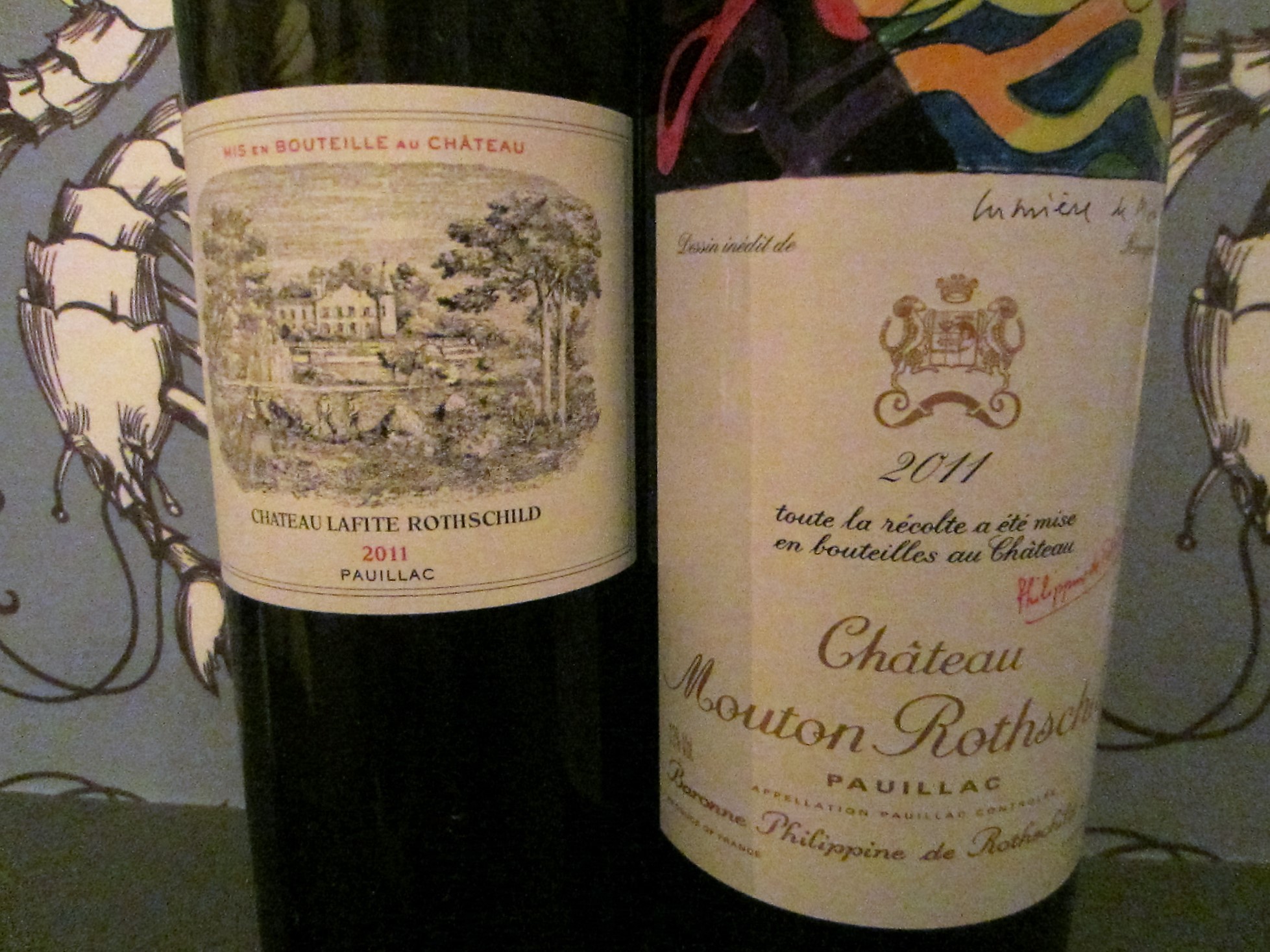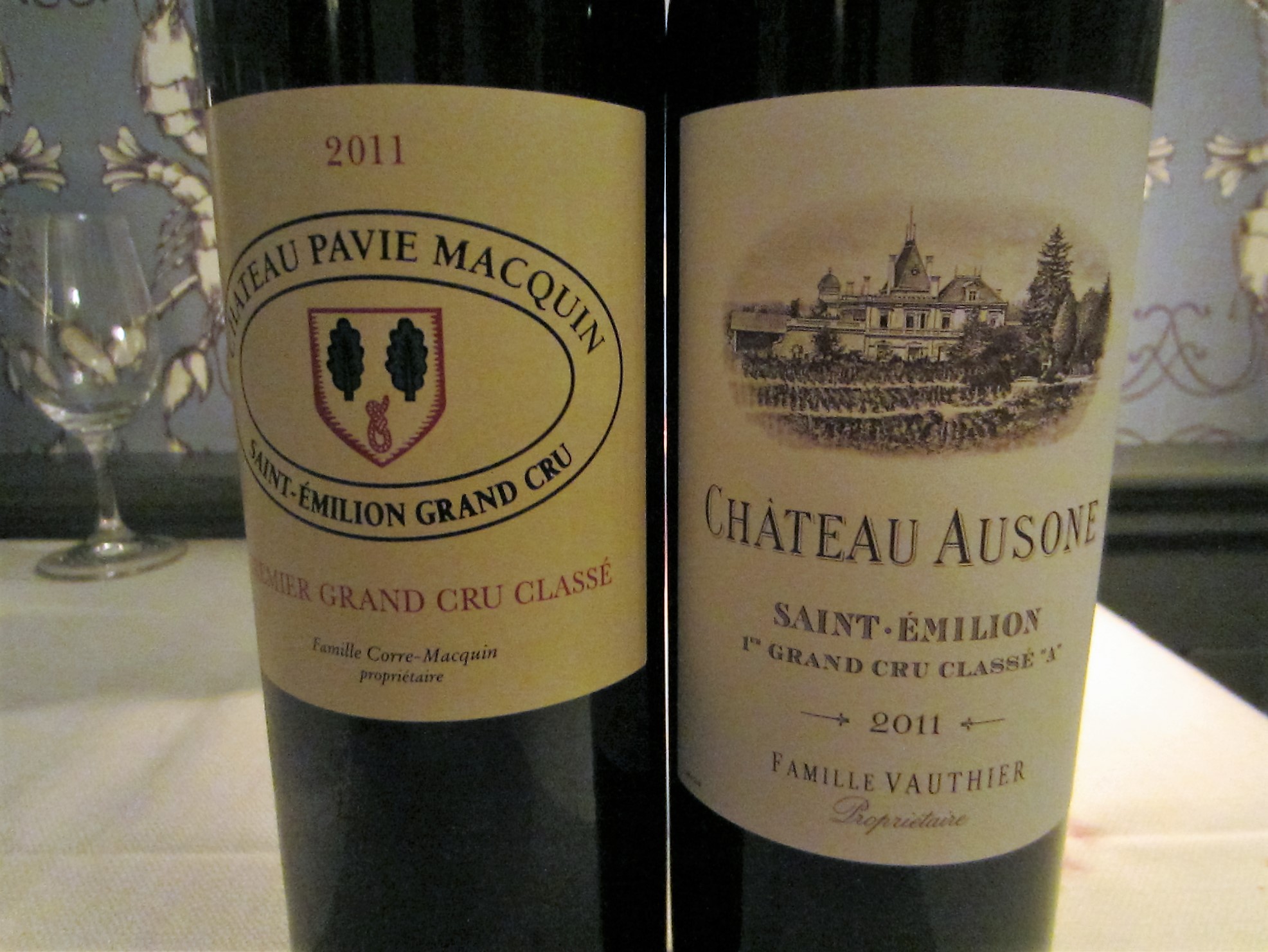CHEVAL BLANC VISITS COPENHAGEN - NOVEMBER 2024
On 7 November 2024, one of Bordeaux's most prestigious properties, Cheval Blanc, visited Copenhagen. Ib Bergkjær, CEO of Sigurd Müller Vinhandel, arranged the tasting, which took place at Hotel d’Angleterre’s restaurant Marchal. Cheval Blanc’s technical director, Pierre Olivier Clouet, conducted the tasting.
We began with the white version of Cheval Blanc's second wine, Petit Cheval 2022. The wine was aromatic, with notes of pineapple and a fresh character. It exhibited fine acidity and minerality, offering a crisp lemon flavor and a refreshing aftertaste. 93p.
Next was Quinault L’Enclos 2018, typical of the vintage with plenty of ripe and spicy raspberries and redcurrants. Powerful with a solid backbone, well-structured, and with a meaty finish. Fine effort. 93p.
Then, Cheval des Andes 2021 from Argentina, a splendid wine, was served. It was made from 49% Cabernet Sauvignon, 48% Malbec and 3% Petit Verdot. Its nose had plenty of blackcurrants and blueberries, and the palate was fresh and lively, with fine structure and finely grained tannins. 95p.
We finished the tasting with four vintages of Grand Vin:
2011 – 57% Cabernet Franc + 43% Merlot. It featured plenty of morello cherries on the nose, excellent intensity and complexity on the palate, great structure and depth, finely grained tannins, and a persistent finish. Despite the less-than-ideal weather conditions, it represents a superb effort for the property. 96p.
2009 – I tasted it the first time at the property 10 years ago, and in November 2024, it was still young and stunning as during the first "meeting". It's tight and concentrated, sophisticated to the core, with remarkable structure, length, and great mid-palate. Wonderful stuff. 99p.
2006 - This vintage faced challenges due to humid weather and rain during the harvest. The wine exhibited spicy fruit along with dry, austere tannins, presenting nice complexity and structure. However, it lacked vitality and excitement. Pierre Olivier Clouet did not produce wine here, as he arrived in 2008. 92p.
2001 – it displayed fine intensity and had an aristocratic style, refinement, and elegance. Despite being 23 years of age, this wine tasted remarkably young. Vibrant and with fine mid-palate. A textbook wine for the property. 95-96p.
During lunch, we tasted the crispy and zesty Petit Cheval white 2021 (94p) and the delightfully aromatic, fruity, and lively Quinault L’Enclos 2020 (93p).
-----
TERTRE ROTEBOEUF IN 21 VINTAGES IN COPENHAGEN ON THE 2ND NOVEMBER 2024
On Saturday, November 2nd, 2024, I arranged a truly memorable vertical tasting of one of Saint Émilion's most iconic wines, Tertre Roteboeuf, at the excellent restaurant Møntergade in Copenhagen. We tasted Tertre Roteboeuf from the vintages 2022, 2016, 2015, 2012, 2011, 2010, 2009, 2005, 2001, 2000, 1999, 1998, 1997, 1995, 1994, 1993, 1990, 1989, 1988, 1985 and 1982. Francois Mitjaville, the owner of Tertre Roteboeuf, attended the tasting.
All the wines came from my private wine cellar, except for the 2022, 2009, and 1982 Tertre Roteboeuf and the 2003 Roc de Cambes, which François Mitjavile kindly supplied. None of the wines I supplied were purchased on the secondary market, which meant no worries about the provenance.
It was an incredible display of François Mitjavile's magical skills as a winemaker. Aromatic, silky, and sensual wines with perfectly balanced tannins that never came out of control or were unripe.
The Danish importer of Tertre Roteboeuf and sister property Roc de Cambes (Cotes de Bourg) is Sigurd Müller Vinhandel in Aalborg, www.smv.dk. This wine merchant has several recent vintages available for purchase.
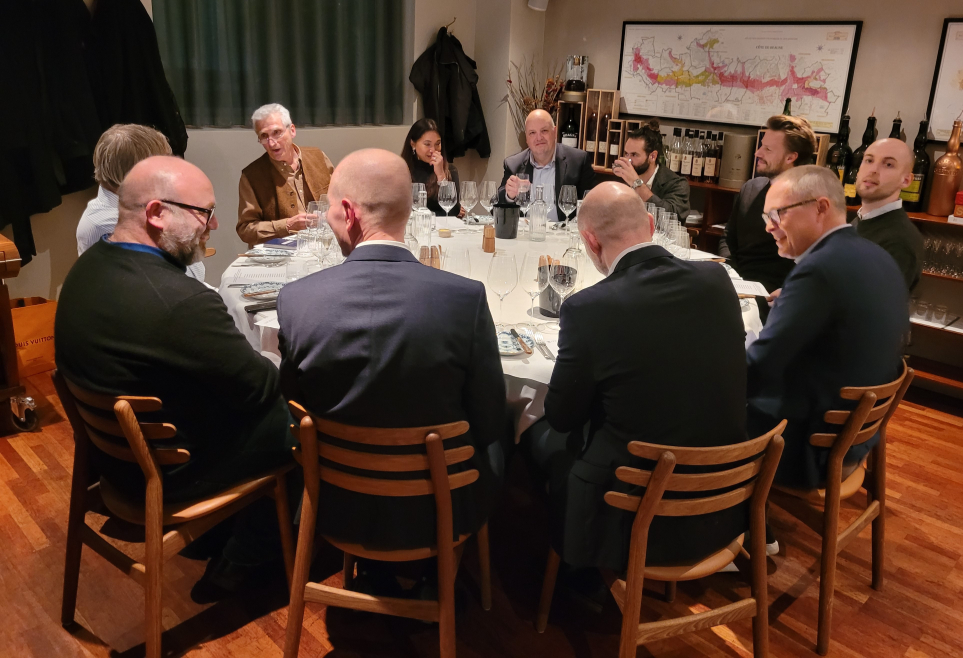
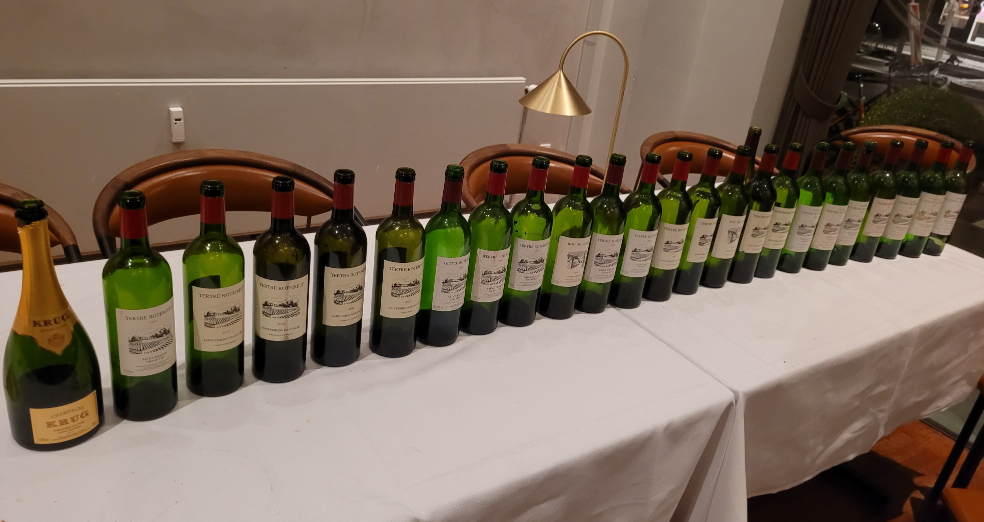
-----
The tasting notes on the wines are presented from the youngest to the oldest for easier reading, even though they were grouped differently in eight flights.
2022: It’s an outstanding vintage for Bordeaux and certainly for Tertre Roteboeuf. The wine had an intense nose of black and red berries, an extensive palette of flavors and complexity, and an excellent mid-palate. It was seamless, with silky berries, grained tannin, a sophisticated touch, and a long, caressing finish. A true dream wine! 98-100p.
2016: This vintage was outstanding across Bordeaux, resulting in numerous extraordinary wines. Tertre Roteboeuf was one of them, showcasing its magical and extravagant style with a beautifully aromatic nose and a rich palate. It embodied the aristocratic character for which this vintage is famous. Enjoying it felt like indulging in silk! 98p.
2015: Francois Mitjavile produced one of the best wines in this vintage. It displayed vibrant dark fruit flavors such as blueberries and blackberries, energy, sophistication, and refinement. The structure was excellent, and the wine had a long and rich aftertaste. With its flashy personality, it demanded a lot of attention. 97p.
2012: This vintage produced wines with great fruitness, attractive approach, and not too complicated to enjoy. Tertre Roteboeuf was one of these and had a splendid nose of black cherries and blueberries, beautiful balance, velvety fruit, grained tannin, and lingering finish. It was a splendidly constructed wine that showed great class and style. It is surely one of the best wines in this vintage. 95p.
2011: Despite the varying weather conditions throughout the year, Tertre Roteboeuf performed quite well. The aroma was delightful, featuring black cherries enveloped in Valrhona chocolate and hints of cocoa. It had great depth, midpalate, and length, complemented by a rich and refreshing aftertaste. I have tasted this wine six times before, and the bottle I had during the vertical tasting was the best I have ever experienced from this vintage! 94p.
2010: This wine was perfectly aligned with the style of the vintage. It was powerful, tight, well-structured, and dynamic, showcasing an incredibly youthful taste. The presence of rich tannins and concentrated black fruit was striking. It displayed remarkable intensity, opulence, richness, depth, and impressive length, culminating in a mega-long and rich finish. Exceptional stuff. 98+p.
2009: The harvested grapes were so rich that alcoholic fermentation lasted one month! It displayed fantastic aromas of wild cherries and cocoa powder. It had a smooth texture, remarkable balance, and great complexity, with an exquisite midpalate and a sophisticated touch. It was graceful, and the long finish highlighted its beauty. All seven times I had this wine, it has performed excellently! 98+p.
2005: I tasted this wine eleven times before the vertical, and it always ticked all the boxes. It was also like that during the vertical; the wine was powerful and tight, dynamic, and showing plenty of perfectly ripe black fruit. Excellent mid-palate, sublime, vibrant, and extraordinarily rich and long finish. You have to adore this masterpiece of winemaking. A meditation wine. 99-100p.
2001: Some wine critics have claimed that this vintage surpassed the quality of the 2000 vintage on the Right Bank. I respectfully disagree! During the vertical tasting, it was quite aromatic, gentle, complex, and well-structured, with a fine midpalate and lingering finish. It lacked the depth and intensity that the 2000 vintage exhibited. 94p.
2000: This wine has consistently been outstanding every time I've tasted it (seven times since 2001). It is an epic effort, showing an intense nose of truffles, cherries, and raspberries. The seamless structure offered stunning depth, midpalate, precision, focus, and complexity, followed by a remarkably long aftertaste. To put it simply, it was a knockout wine! 98+p.
1999: During the vertical, I tasted this wine for the first time and wasn’t disappointed. It displayed a sensual character with elegance, finesse, spicy raspberries, and morello cherries. The bright acidity complimented the tasty fruit quite well, and the balance was on the spot. A smooth and lingering finish rounded off this well-made wine pretty well. 92p.
1998: This wine was impressive right from the beginning. When tasted in early summer of 2000, its complexity, richness, and luscious raisin-like quality were overwhelming. It had an amazing aroma filled with concentrated berry scents. Thirteen years later, in November 2013, the wine was sensual, exhibiting excellent intensity of sweet cherries and great sweetness and complexity. During the vertical tasting, it displayed striking elegance and finesse. 98p.
1997: It’s a vintage you easily forget, but this wine has maintained the style of the property well. It was aromatic, flavorful, gentle, tasty, and well-balanced, with a nice acidity, smooth tannins, and a pleasant aftertaste. Quite enjoyable. 91p.
1995: It was my first experience with this vintage. The aroma displayed a wealth of black cherries and raspberries, but the fruit wasn’t as sweet as one might typically expect from this property. On the palate, I detected a slight dryness. It was a well-structured wine with a silky texture and smooth aftertaste. I was expecting more energy and tension from this wine, considering the reputation of the vintage. 92p.
1994: Despite cold and rainy weather, the Merlot variety did well on the Right Bank. I had different impressions of this wine after tasting it three times, the last time in 2007. Seventeen years later, it miraculously kept its freshness well, had dusty flavors, had nice complexity, and was tender and nicely balanced. It is a charming wine. 91p.
1993: Weather gods weren’t kind to Bordeaux in this vintage; even Francois Mitjavile’s magical touch couldn’t help that much with his wine. Fragile, light, slightly rough tannin, tasty fruit, round and pleasant. 86p.
1990: This wine was at its best during the vertical with an intense nose of blueberries and blackberries, great balance, structure, depth, and plenty of perfectly ripe black fruit on the palate. Fine complexity and midpalate. Vibrant and expressive. Flamboyant wine. 96p.
1989: A wine where sun-drenched fruit and fat tannin complemented each other perfectly. There was fine structure, a sophisticated touch on the palate, and a long aftertaste, although with a slightly bitter sensation in the end. Fine effort. 93p.
1988: I last tasted this wine in 2000. It was then an enjoyable wine with fine balance, featuring perfectly ripe raspberry and cherry flavors, a hint of raisin, and fine intensity. It had a lovely structure and a long finish on the palate. Now, 24 years later, it hasn't changed much and has aged gracefully. A tasteful wine. 92p.
1985: This was the property's first vintage with new oak (50%). Francois Mitjavile's importer in England convinced him that using new oak would provide the wine with great aging potential, and this Englishman even paid for the new barriques. I first tasted this wine in 1998, which was a fine experience. It improved when I tasted it in 2019! In November 2024, it tasted exactly like in 2019, if not better! It displayed intense cherry and raspberry flavors and had much finesse, silky tannin, and subtle structure. Vigorous and entertaining wine. 95p.
1982: Francois Mitjavile believes this vintage was the first time he fully realized his vision for winemaking. I have tasted this wine twice before, experiencing different impressions: a fruity and delicate profile in 1998 and a fresher, younger, and more intense character in 2019. When I tasted it in a vertical tasting, it resembled the 2019 version. Would this wine be better if it aged in new oak? 88p.
-----
VERTICAL OF CHATEAU RAYMOND LAFON ON THE 19TH OF APRIL 2024, WHICH TOOK PLACE AT THE PROPERTY
The owner, Jean-Pierre Meslier, arranged this vertical with Bill Blatch, renowned for his great expertise in Bordeaux’s sweet wines. I tasted 21 vintages from youngest to oldest. It was an impressive display of high-quality wines, even though a couple of great vintages, like 2001 and 2003, were absent from the line-up. This unclassified property certainly rubs shoulders with the absolute top wines in the district.
Tasting notes:
2023: Only half of the harvest was used for the Grand Vin due to a rigorous selection process. The wine showcased intense aromas of honey melon, acacia honey, and orange peel. On the palate, it was sophisticated, complex, and layered, with excellent acidity. The aftertaste was rich and prolonged. It was a beautiful effort overall. 96p.
2022: This subtle and sophisticated wine featured aromas of heather honey, botrytized guava, candied oranges, and dried apricots. It was rich, with fine acidity, a vibrant character, finesse, and a delicate, sweet finish. It was an excellent effort. 95-96p.
2021: Spring frost wiped out 50% of the harvest, resulting in a yield of just four hectoliters per hectare. This wine wasn’t convincing from the barrel, but I have to say it excelled significantly after bottling. It had very intense flavors of botrytized orange peel, citrus, sweet grapefruit, and apricot. It was complex, had splendid acidity, a rich aftertaste, and was simply a terrific effort. 95p.
2020: Rainfall during the spring and at the end of the harvest, combined with a summer drought, negatively impacted the crop quality. Only 33% of the harvest was deemed of good quality and was included in the Grand Vin. The aromas included honey melon, mango, and sweet lemon, all contributing to a flavorful profile. It had fine acidity and a refreshing honeyed aftertaste. 93p.
2019: Only 40% of normal production (16 hl/ha) was used for Grand Vin, and the quality of these grapes was excellent. Sweet pineapple, apricot, mandarin peel, botrytized almonds, and honey melon. Vibrant, refined, and with great acidity on the palate. Long, honeyed finish. Superb effort. 95p.
2017: A third of the crop was lost to frost in April. However, the resulting wine is impressive, characterized by its freshness, superb acidity, and sweetness. It featured intense flavors of botrytized almonds, pear, peach, and apricot, showcasing splendid complexity, elegance, and finesse. Overall, it was an excellent effort. 95-96p.
2016: This vintage offered less intense flavors and concentration than 2017. Nevertheless, this wine was more elegant and refined than in 2017. It boasted aromas of candied orange peel and heather honey, great acidity, and a rich honeyed finish. Splendid wine. 94p.
2015: It was an exceptional vintage for the property, with ideal growing conditions and a widespread botrytis. The potential sugar content was quite high. The wine was rich and powerful, perfectly balanced, and showcased flavors of sweet pineapple, candied orange peel, and guava. It also had great acidity and a long, honeyed finish. Truly remarkable! 96p.
2014: The harvest was small in quantity, but the grapes brought in were of high quality. It had a terrific nose of heather honey, candied orange peel, and sweet grapefruit. On the palate, the sweetness was expertly balanced by a great acidity. It was complex and refined, with a long finish. Superb effort. 95p.
2010: Many botrytis-affected grapes were harvested, primarily collected during just two pickings. The harvest was clean and straightforward, with no insects or diseases. The result is a wine that boasts plenty of pineapple and grapefruit aromas, displaying a sophisticated richness and exquisite balance. It is a truly impressive effort. 96+p.
2009: This vintage enjoyed ideal growing conditions all year round. The wine was spectacular on the nose and palate with a great range of botrytised flavors like almonds, pineapple, pear, apricot, acacia flower, and exquisite sweetness and acidity. Incredibly long on the palate with a beautiful honeyed aftertaste. Fabulous stuff. 96+p.
2008: Small production. It had a great nose of candied orange peel, acacia honey, and citrus. Acidity kept everything tidy and matched fruit sweetness perfectly. It was a captivating wine with exquisite balance and had a lovely structure and great style. Splendid effort. 94p.
2006: It was a year with unusual temperature fluctuations. The wine exhibited an appealing aroma of acacia flowers and honey alongside nutty flavors and good acidity. Its lovely structure and delicate balance resulted in an elegant and seductive wine. 93p.
2005: Magnum. After the good flowering period, the weather conditions remained ideal throughout the harvest, which required only three pickings. 70% of the harvest went into Grand Vin. Pure, very aromatic, with a huge intensity of flavors like acacia honey, apricots, and walnuts. Rich, outstanding balance, and sophisticated touch. It's a fabulous wine with great keeping potential. 96p.
2002: Magnum. It was a late harvest that finished at the end of October. The wine was well-balanced, delicate, and light but with seductive elegance. It was flavorful with notes of apricot and orange peel, and it had a delicious sweetness, bright acidity, and lingering finish. A graceful effort. 93p.
1999: Magnum. This wine seemed to be aging rapidly because it didn’t taste as splendid as in 2003 when I last tasted it. In April 2024, it displayed a nice range of botrytized flavors like brown sugar, honey melon, and apricot. There was nice sweetness and acidity, and a light honeyed aftertaste. Nice and tasty wine. 92p.
1995: It was an early harvest that ended on the 7th of October and lasted only 11 days! The wine offered strong flavors of apricot marmalade, brown sugar, heather honey, and candied mandarine peel. Plenty of sweetness was expertly matched by bright acidity. The aftertaste was lingering and very long. Terrific stuff. 95p.
1990: This wine was a pure enjoyment. It had intense flavors of heather honey, mandarin peel, and sweet grapefruit. There was an amazing complexity and excellent acidity that balanced the sweetness. It was unctuous and sophisticated, finishing richly with honey notes. 96-97p.
1987: It tasted as if it had peaked a long time ago. It was light on its feet, agreeable, and flavorful, but a hint of sweetness remained. 87p.
1980: Late harvest. It is a remarkably well-preserved and lively wine in a so-so vintage. It exhibited aromatic notes of delicate citrus and sweet lemon, nice balance and acidity, and a honeyed finish. Very good effort, indeed. 91p.
1979: Late harvest that lasted one and a half months. The wine tasted like the twin brother of the 1980 vintage, sharing the same characteristics. There were still several years left in the tank. It was delicate and tasty. 91p.

-----
Wines from Peter Sisseck tasted in October 2023 in Copenhagen
Rocheyron is a joint venture in Saint Emilion between Peter Sisseck and Silvio Denz (Lafaurie Peyraguey and Peby Faugeres).
PSI is made from grapes purchased from vineyards other than Pingus and Flor de Pingus.
La Fleur de Rocheyron 2016 – 100% Merlot. This is a second wine of Rocheyron. Juicy berries and soft tannin, sappy and lively. Aromatic cherries on the nose and fine acidity, structure, and length. Lingering aftertaste. Nice effort. 91p.
La Fleur de Rocheyron 2017 is understandably lighter than vintages from 2016 and 2018. It offered tasty black and red berries on the nose and a palate with lush fruit, soft texture, and delicate aftertaste. Catchy wine. 90p.
La Fleur de Rocheyron 2018 – this vintage is wonderful all over Bordeaux, and here you get everything you want from a wine. Aromatic cherries and blueberries have a creamy and juicy palate, are nicely structured, and have a lingering finish. Heartbreaker stuff. 91-92p.
Rocheyron 2019 – 70% Merlot + 30% Cabernet Franc. Spicy black fruit (blueberries and cherries) mixed with redcurrants and raspberries, splendid intensity, elegance, and finesse on the palate, vibrant with fine acidity, splendid midpalate, well structured, and long aftertaste. Excellent effort, indeed. 94-95p.
Rocheyron 2020 - intense black fruit (blueberries and cherries) dense and powerful, vibrant on the palate with fine acidity, great midpalate, well structured, and long aftertaste. Stupendous wine. 95-96p.
Rocheyron 2021 - aromatic raspberries and redcurrants, freshness and energy, fine complexity, structure and length, cool fruit and tannin, long aftertaste. Understandably lighter than 2022, 2020, and 2019, but more elegant. Delicious mouthful. 93p.
Rocheyron 2022 (barrel sample) – has enough potential to be the best vintage ever produced at the property. It's a perfect mix of the best things from 2019 and 2020 vintages. Dense, juicy, powerful, wonderfully structured, and balanced, with great midpalate and mega finish. 96p.
PSI 2021 – 90% Tempranillo + 10% Garnacha. Aromatic black cherries, juicy, silky fruit, tannin, velvety texture, fine acidity, elegant, vivid, well-structured, and a long fruity finish. It's delightfully tasting stuff. 92p.
PSI 2022 (barrel sample) – aromatic black cherries and roses, juicy, silky fruit, tannin, velvety texture, fine acidity, elegant, vivid, well-structured, and a long fruity finish. Slightly more concentrated than the 2021 version. Splendid effort. 93p.
Flor de Pingus 2021 – second wine of Pingus. Intense cherries, blackcurrants, and raspberries, energetic and complex, very ripe with relatively strong tannin, splendid structure, and long meaty finish with a little oak dryness. I will benefit from a couple of years. In the cellar. 93p.
Flor de Pingus 2022 (barrel sample) – spicy raspberries and blackcurrants, freshness, lively, creamy fruit and grained tannin, vibrant, superb complexity, and midpalate. Lush and lingering aftertaste. Impressive second wine! 95p.
Pingus 2021 – 100% Tempranillo. Strikingly aromatic blueberries and blackcurrants on the nose, freshness and vibrancy on the palate, silky texture and velvety tannin, amazing structure, depth, and midpalate. Long aftertaste. Meditation wine. 98p.
Pingus 2022 (barrel sample) – intense dark berries and floral scents, perfect fruit ripeness, vibrant with silky tannin, seamless structure, sophisticated touch, multi-layered, awesome complexity, spectacular midpalate, long meaty finish. This is a beautifully crafted wine! 99p.
-----
Cos d’Estournel vertical, Friday the 17th of June 2022
Before tasting the 24 vintages of Cos d’Estournel that evening, I had not had the opportunity to try 11 of these: 2012, 1998, 1996, 1995, 1988, 1982, 1981, 1977, 1973, 1926, and 1916. Experiencing these "missing" vintages significantly enhanced my knowledge of Cos and deepened my understanding of the property's style. The combination of power and elegance in these wines is truly thrilling! This second growth from St. Estèphe is one of Bordeaux's most refined and terroir-driven wines. It is definitely one of my favorite wines from Bordeaux!
The 2013 and 2018 white Cos were purchased at the chateau, while the 2009 white Cos and all the reds were acquired from various auctions and wine shops.
Flight 1. White Cos d’Estournel. 2009, 2013, and 2018.
Imho 2009 and 2013 were similar: freshness, finesse, aromatic white flowers, crispiness, splendid acidity, and lingering aftertaste. 93p for both. 2018 was lighter and more elegant than 2009 and 2013, with less marked acidity and a shorter aftertaste. 91p.
Flight 2. Cos d’Estournel 1995 and 2002.
1995 – I’m not convinced this vintage was splendid on both the Left and Right Bank. Merlot ripened, in my opinion, better than Cabernet Sauvignon. Cos in this vintage displayed some peppery notes and a slight lack of ripeness. Edgy, firm, and stern. Maybe it will soften at some point in its life. 90p.
2002 – you can easily say it was a Cabernet Sauvignon vintage, as Merlot had great difficulty reaching good ripeness because of challenging weather. Anyway, Cos managed to make a wine of satisfactory quality, displaying the typicity of Cabernet Sauvignon well. Leather, cedar wood, forest floor, mineral, strong backbone and structure, sappy, long, and persistent finish. Has a long life ahead. 93p.
Flight 3: Cos d’Estournel 1977 and 1973.
1977 – I didn’t expect this wine to be that lovely at all, thinking of all the weather problems this vintage experienced. A sensual nose of ripe(!) blackcurrants, fine acidity, tasty, complex, and lovely finish. It’s nice to drink now and for 3-5 more years. 88p.
1973 – another surprise. The cold and rainy summer and rain during the harvest didn’t promise good things for the vintage, but I've got to say Cos made quite a fine wine. Aromatic and delicate, with gentle tannin, milky (yogurt) on the palate, vibrant with lovely complexity. 89p.
Flight 4. Cos d’Estournel 1988 and 1982.
1988 – better vintage on the Right Bank than on the Left because of Merlot ripening perfectly. Wines on the Left Bank suffered a little from Cabernets not reaching perfect maturity. Cos made much more than solid wine. Very Cabernet Sauvignon with tobacco/cigar box, wet earth, cassis, and black truffle. Powerful, strong backbone, vibrant, splendid complexity, and long aftertaste. It’s classic St. Estephe wine for long-term cellaring. 94p.
1982 – one of the best vintages in Bordeaux’s history and one that, after 40 years, still keeps its fine ingredients intact. Cos was a peach of wine with gorgeously intense Cabernet Sauvignon displaying leather, cedar, and tobacco leaf. Plenty of creamy blackcurrants and grained tannin, plus sweetness. Vibrant, refined, and sophisticated. In full blossoming. Can live forever! 98p.
Flight 5. Cos d’Estournel 2009 and Pagodes de Cos 2009.
2009 vintage is an excellent one for Cos. Intense and aromatic nose of black fruit with the scent of yogurt. Distinguished and classy. Luscious blackcurrants, grained tannin, great acidity, highly complex, and very long on the palate. Silky with great elegance. There is nothing to complain about here. Perfect modern Bordeaux with great style. One to enjoy over many years to come. 98+p. My WOTN, but it was strongly challenged by 1982 and 2015 Cos!
The second wine of Cos, Pagodes, from magnum, mirrored the Grand Vin quite well. Of course, it did not have the same intensity, depth, and length as Grand Vin, but it offered large quantities of delicacy, silky texture, and seductive fruit. 92p.
Flight 6. Cos d’Estournel 1976 and 1981.
1976 - a hot and humid vintage in Bordeaux. Cos seemed not to be affected by that and displayed some fine things. Cabernet Sauvignon had flavors of crushed rocks, tobacco leaves, and grilled bacon, with lively, lovely complexity and structure. Persistent aftertaste. There is a lot of great pleasure here. 94p.
1981 – this vintage looked sensational before harvest, and wine people in Bordeaux expected a repeat of 1961. Unfortunately, it rained a lot during the entire harvest. However, several properties somehow managed to produce splendid wines, and Cos was one of them.to produce splendid wines in some way Powerful with a strong backbone, minerality, great structure, delicate balance, complexity and length, and a long finish. It can easily be kept for 10-15 more years. 93p.
Flight 7. Cos d’Estournel 1985 and 1986.
1985 – my first Bordeaux vintage to be experienced live on-site in September 1985. Perfect sunny weather through the harvest. Despite huge yields, the wines from this vintage have kept extremely well. It was called a feminine vintage by several wine critics, but it’s not entirely correct, imho. Cos expressed the grace, elegance, and beauty of this vintage. Roasted bacon, milky, black winter truffles, sensual, great acidity, bright complexity, sophisticated touch, and long lingering aftertaste. I had a slightly better example of this wine in 2015, but no complaints here! 96p.
1986 – after a solar 1985, it returned to a more classic Bordeaux style in 1986. Cos was a traditional St. Estephe wine with a lot to offer. Full-bodied, big fruit intensity, Cabernet Sauvignon in full blossom, great structure, and midpalate. Vibrant. Long, meaty finish. There are many years to go. 95p.
Flight 8. Cos d’Estournel 1996 (magnum) and 2006.
1996 – from a magnum bottle. You can compare it to other vintages ending with the “6” digit, but the fruit ripeness is better here than in 2006, and perhaps the complexity is slightly more significant here than in 1986. To be drunk by your children when they reach the right drinking age. 95p.
2006 – damp and humid weather conditions in Bordeaux. Cabernet Sauvignon came through these in a much better way than Merlot. Cos is the typical Cabernet Sauvignon wine with power, a strong backbone, minerality, acidity, vibrancy, big tannin, and a meaty finish. It’s still very youthful and needs a couple of decades to mature. 94p.
Flight 9. Calon Segur 2005 magnum (dark horse) and Cos d’Estournel 2015.
I think that Calon Segur 2005 put some “clothes” of Cos on during this vertical! Potent, with plenty of sweet and fragrant blackcurrants, bright acidity, lush tannin, and persistent aftertaste. 92p.
2015 – very aromatic on the nose with fully ripe blackcurrants, creamy and luscious on the palate with fat and ripe tannin. Juicy and lively. A considerable amount of oak was kept quiet by plenty of flashy fruit. It has great complexity, splendid structure, and a long, meaty finish. This wine will surely gain even more complexity in the coming years. Mesmerizing wine. 98p.
Flight 10. Cos d’Estournel 1953 and 1955.
1953 – Danish bottling. I’d tasted this vintage before, in September 2015, and it was also a Danish bottling. The difference between these two bottles was that the bottle I tasted in 2015 had always stayed in the cold cellar of the Danish wine merchant since its release. The one we tasted during vertical in June 2022 had probably traveled worldwide because it tasted pretty old. Sappy and still alive, but the fruit was somewhat mushroomy, and tannin was drying out. 86p.
1955 – Bordeaux bottling. It was similar to 1953, with little fruit left, dry-out tannin, and champignon taste. 85p.
Flight 11. Cos d’Estournel 1926 and 1916.
1926 – Bordeaux bottling. Sappy with nice acidity, lively, tasty, nicely balanced, and delicate finish. It is still alive and a pleasant one to taste. 91p.
1916 – Danish bottling. Made during the First World War by women because male workers were sent to the front. Keeping well for a 106-year-old wine, a bit mushroomy but otherwise pleasant, round, and soft. 89p.
Flight 12. Cos d’Estournel 1998 and 1952.
1998 – this vintage in Bordeaux was blessed with warm weather and became incredibly successful at Right Bank, with many magical wines produced. Left Bank wines hadn’t been largely that successful. But Cos contradicted this postulate and was a badass wine. It is intense on the nose and palate with creamy blackcurrants, minerality, delicate acidity, sweet tannins, and great complexity. It was vibrant and had a lovely structure. Long, lingering finish. 96p.
1952 - Bordeaux bottling. I strongly suspected that the 1950s in the vertical came from the same cellar. Why? Because this particular vintage tasted similar past its peak compared with 1955 and 1952. 86p.
Flight 13. Cos d’Estournel 2014 and 2011.
2014 – a Bordeaux vintage marked by excellent acidity and almost perfectly ripe fruit and tannin. Cos fitted perfectly in that description. Firm, tight, and with plenty of fruit and tannin. Strong backbone, vibrant acidity, impressive structure and depth, and a long, persistent finish. It's as classic as it can be. Long-time keeper. It was the year of the arrival of the new technical director, Aymeric de Gironde, who replaced Guillaume Prats. 96p.
2011 – unstable weather conditions in 2011 didn’t allow winemakers in Bordeaux to accomplish great things. There was no full ripeness of the grapes and tannins. Cos made a pretty nice wine anyway. The exciting thing was that Jean-Guillaume Prats, manager of Cos, didn’t overdo and over-extract this wine as he did to some extent in 2010. This wine was powerful and had rough edges and rusticity. Very Cabernet Sauvignon. It needs time to soften and reveal its qualities because there is potential. 92p for now.
Flight 14. Cos d’Estournel 2017 and 2012.
2017 – this wine had a specific flavor when tasted. It had a milky or yogurt flavor on the nose, which I often find tasting Cos. It comes from the soil. Tight, strong, and well-balanced, aromatic, great acidity, vibrant. Tobacco leaf and cigar box. Magnificent structure and depth. Long and persistent aftertaste. Grace and power at the same time. 96p.
2012 – this Bordeaux vintage offered many beautiful, tasty, and immensely attractive wines. They may not have the structure, complexity, and length of the famous vintages like 2010, 2015, 2016, 2018, and 2019, but they are an extremely affordable and excellent choice at restaurants. Furthermore, 2012 can now be enjoyed while you wait for the big vintages. Cos was precisely just that; juicy, luscious, and had a caressing finish. 93p.
-----
Latour vertical in Copenhagen, Friday the 8th of October 2021
Champagne:
Salon Blanc de Blancs Le Mesnil 2004 was very mineral with quite pronounced acidity. Notes of green apples and lemongrass, still very young on the palate. It tastes light but will probably be better in 10 years. 93+p.
Krug Vintage 2008 was in another league than Salon 2004. Flamboyant champagne with a fabulous nose of red grapefruit, yellow plums, and sweet pineapple. Incredible complexity and sophisticated taste. Full-bodied and with a lengthy badass taste. A legend in progress. 98+p.
Red wines:
Pichon Comtesse 1996 (magnum) had a well-defined Cabernet Sauvignon nose with notes of forest floor, cigar box, and tobacco leaves. Stylish, complex, and with fine structure. Textbook Pauillac. 94p.
Latour 1996 was similar to Pichon Comtesse 1996 (both appeared on the same flight) but tasted more refined. It has great style and a sophisticated touch here as well. 95p.
Latour 1970 showed fine Cabernet Sauvignon notes on the nose, fine balance and complexity on the palate, and a long finish. It is a well-preserved wine with everything in splendid order. It's still going strong. 95p.
Latour 1955 was so fine, so complex, and so refined. It had much to offer with its power, vibrancy, fatness, exceptional depth, and length. Everything was perfect here. It was the third time I tasted it, and this bottle was undoubtedly the best I ever had. Fifteen years more life, at least. 99p.
Latour 1953 was somewhat dusty with notes of tobacco leaves and grilled bacon. Rather elegant than powerful with delicate complexity and balance. After one hour in the glass, it picked up a scent of grated milk chocolate on the nose, making the wine very seductive. 93p.
Leoville Barton 1934 was showing exceptionally well. It was vibrant and energetic, with great elegance and finesse, and its acidity remained intact. It’s extremely well done for an 87-year-old wine, and I’m proud to reward it with 96p.
Latour 1934 had some mushroomy sweet fruit on the nose and a nicely balanced palate, but it was clear that this wine was declining, and the fruit was running away. Probably a bottle that “visited” many cellars on its way to Denmark. 90p.
Latour 1961 was, as expected, a monumental wine. Sixty-years old wine still needs to be ready. Still young and vigorous. Oceans of fruit and tannin are perfectly supported by underlying acidity. Enormous potential! 99-100p.
Mouton Rothschild 1962 was so classic for the property with notes of forest floor and cigar box, great complexity and elegance, sophisticated touch, and exquisite balance. Impressive stuff. 96p
Latour 1962 had different fine characteristics than Mouton Rothschild 1962 (same flight), was coarser on the palate, and seemed older on the nose. Maybe there were better bottles of it we tasted here. It was the first time I tasted Latour in this vintage. 91-92p.
Latour 1966 had a fine blackcurrant-scented nose and added notes of grilled bacon. Typical for the vintage with roughness and strong tannin on the palate. Meaty finish. It can keep everything intact for a decade at least. 94p.
Richebourg DRC 2016 was an intermezzo. It wasn’t planned at all to taste this wine. One of the participants in the tasting meant we should taste it and calibrate and refresh our taste buds. All I can write about this wine is that it is an incredibly concentrated and sophisticated juice! An awful lot of wild strawberries and almonds in this wine! 99-100p.
Latour 2005 was unfortunately corked. NR.
Latour 2003 had the same characteristics as its brother, 2000. They both were tasted on the same flight, where 2005 was “disqualified” by being corked. This wine reflected the scorching weather in August by displaying the flavor of licorice. It’s a giant with walls of fruit and tannin. 98p.
Latour 2000 was still dressed up in baby “clothes” Great potential and many years to go. Gobs of fruit and tannin waiting patiently to come up to the surface. 99p.
Lynch Bages 1982 turned out to be among the best wines of the evening. Potent with an amazingly aromatic nose of tobacco leaves and black truffle. Smooth as silk on the palate with great complexity, depth, and length. Awesome stuff. 98p.
Latour 1982 had to stand slightly in the shadow of Lynch Bages 1982 (in the same flight), but I suspect this bottle wasn’t of perfect provenance. I had a better example of this wine before. Tight, strong, gobs of perfectly measured fruit and tannin, fabulous complexity and length. 97+p.
-----
Lafite Rothschild, Duhart Milon, L’Evangile, and Rieussec, all owned by Domaines Barons Rothschild, visited Copenhagen in January 2020
The tasting for the wine journalists took place at the excellent restaurant Marchal in Hotel d’Angleterre, Copenhagen. The theme was 2010 and 2000 vintages from each property.
Ib Bergkjær, CEO of Sigurd Müller Vinhandel, and Jean-Sébastien Philippe, Lafite Rothschild’s commercial director, tutored the tasting in an informative and entertaining way. Sarah Chassin, buyer/sales manager from negociant company Wings (Francois Thienpont), who contributed to arranging the tasting, also attended it.
We were treated to two great vintages in Bordeaux, 2010 and 2000 (red). It was fascinating to compare both vintages, also in the context of technological improvements in vineyard treatment, the influence of optical sorting of grapes, the time of harvesting grapes (phenolic ripeness), and different winemaking.
I was in Bordeaux during the harvests in 2000 and 2010. One thing struck me, and it was yield per ha. It was huge in 2000 and less than normal in 2010, but you really can't taste the difference. Both harvests were quite easy to manage without diseases occurring during the growing season.
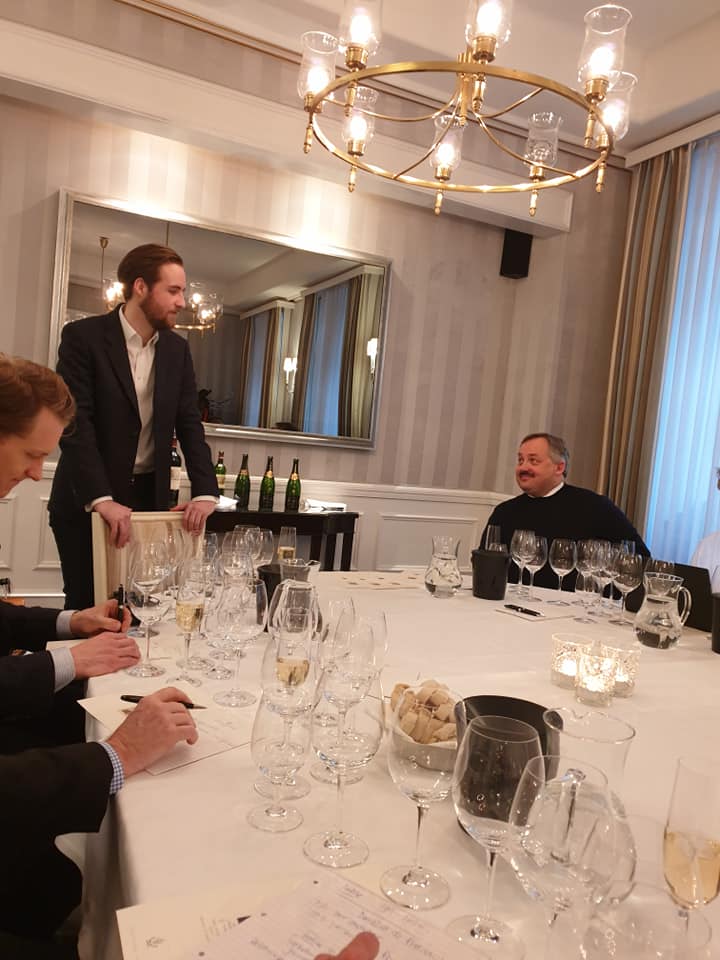
Jean-Sébastien Philippe (left) and Ib Bergkjær (right)
We started with Duhart Milon, a property situated in Pauillac, app. 5 km east of Lafite Rothschild and close to Gironde river.
2010 – 63% Cabernet Sauvignon + 37% Merlot. Served from magnum. Aromatic and truffy on the nose, succulent, spicy fruit, minty, fine complexity, persistent finish. A well-balanced wine with many years of further development. Fine quality. 92p.
2000 – 80.5% Cabernet Sauvignon + 19.5% Merlot. Potent, creamy, minty, tobacco leaf, truffles, splendid complexity, and fine finish. Well-designed wine with a strong backbone to keep for 10+ years more. 93p.
Next was L’Evangile from Pomerol.
2010 – 88% Merlot + 12% Cabernet Franc. Creamy cherry fruit on the nose, fat texture and fat tannin, great balance and complexity, strong backbone, and long finish. Big scaled wine with a lot of keeping years in it! 95-96p.
2000 – 91% Merlot + 9% Cabernet Franc. Creamy and chocolate/cocoa-covered black cherries, still quite young for a two year old wine to be, lot of fruit and tannin, great concentration and complexity. I bet yield per ha in 2000 was significantly higher here than in 2010 (31 hl), but this wine is not diluted! 96p.
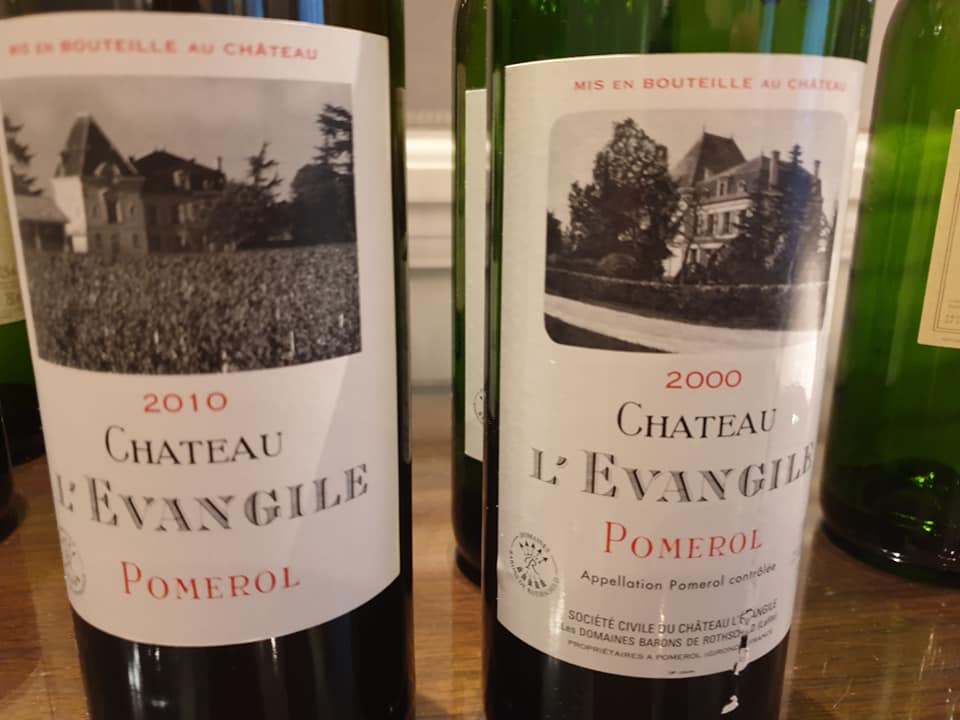
Then Lafite Rothschild, one of the 5 First Growths in Bordeaux and one of 3 FGs situated in Pauillac. World-famous wine!
2010 – 87% Cabernet Sauvignon + 13% Merlot. Very aromatically scented nose with a heavy dose of sophisticated touch. It is distinguished and incredibly complex, it sticks fast to the tongue, meaning it can be sliced, incredibly structured, and with an awesome long finish. 99-100p.
2000 – 93% Cabernet Sauvignon + 9% Merlot. “Doors” are hermetically closed; incredible promise awaits, and it probably needs several years to open up. It was completely another story in December 2016, when I opened my bottle (bought en primeur) of Lafite 2000. It was in full blossom and welcoming! 97p.
An additional vintage of Lafite, 1964, was served. It was better on the palate than on the nose. It is an OK old wine. Lafite was one of several properties on the Left Bank caught by rain at the end of the harvest in 1964.
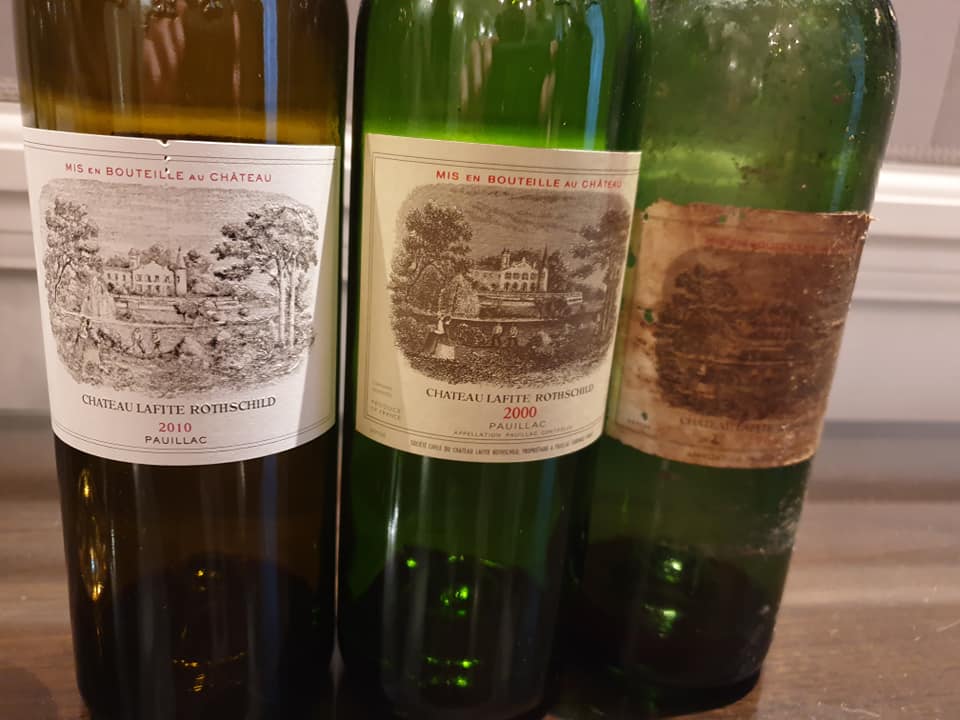
We finished the tasting with Rieussec from Sauternes.
2010 – 92% Semillon + 5% Sauvignon Blanc + 3% Muscadelle. It was very aromatic on the nose with botrytised flavors of pineapple and grapefruit, orange peel, candied fruit, nice acidity, outstanding balance, and a long finish. This vintage was very successful in Sauternes & Barsac compared to 2009 and 2005.
2000 - 65% Semillon + 24% Sauvignon Blanc + 11% Muscadelle. This vintage was characterized by excellent sunny weather, a little rain, and a lack of botrytis. I believe grapes got concentrated and sweet by so-called passerillage (grapes drying in the sun) instead of being affected by botrytis fungus. Surprisingly, acidity in this wine is more present than in 2010. Very sugary, molasse, thick, and long sweet finish. Goes perfectly with blue cheese like f.i. Roquefort.
For lunch, we were treated to two vintages of L’Evangile, 2014 and 2008. Both vintages are classic cool-climate Bordeaux wines. They were similar: black ink-coloured, tannic, thick, succulent, with big depth, strong backbone, and long finish. To keep untouched for 20+ years! 93p for each wine.
-----
EXTRAORDINARY TASTING ON THE 2ND OF MAY 2020 IN COPENHAGEN! LIBERATION OF DENMARK
Crazy, crazy Saturday dinner on the 2nd of May 2020 with friends (Covid-19 restrictions, and we did keep our distance, washed our hands, etc.) and enjoyed some extraordinary bottles. We celebrated Denmark's liberation from Nazis by the Brits, which happened on the 4th of May 1945. So, we mainly tasted 1945s, but wait a minute….
Someone wise once said, “There aren’t great vintages, only great bottles!” This was so obvious during the tasting. It was blind and very entertaining! The wines served were in regular and magnum bottles, and all were chateau-bottled.
We kicked off with a magnum of Dom Perignon 2004 in magnum, which was rather semi-dry than dry, elegant, and with finesse. Lighter than usual. 92p
Flight one:
Laville Haut Brion 1939 – very dark yellow, a nose of sherry and lanoline, tasted like demi-sec wine with a touch of sweetness, interesting to taste. A curiosity. 88p.
Laville Haut Brion 1945 – much younger in color than 1939, so I thought it was 1939 before the identity of both was revealed. Still virile and lively, acidity was still there, complex, tasty, and with a smooth finish. 93p.
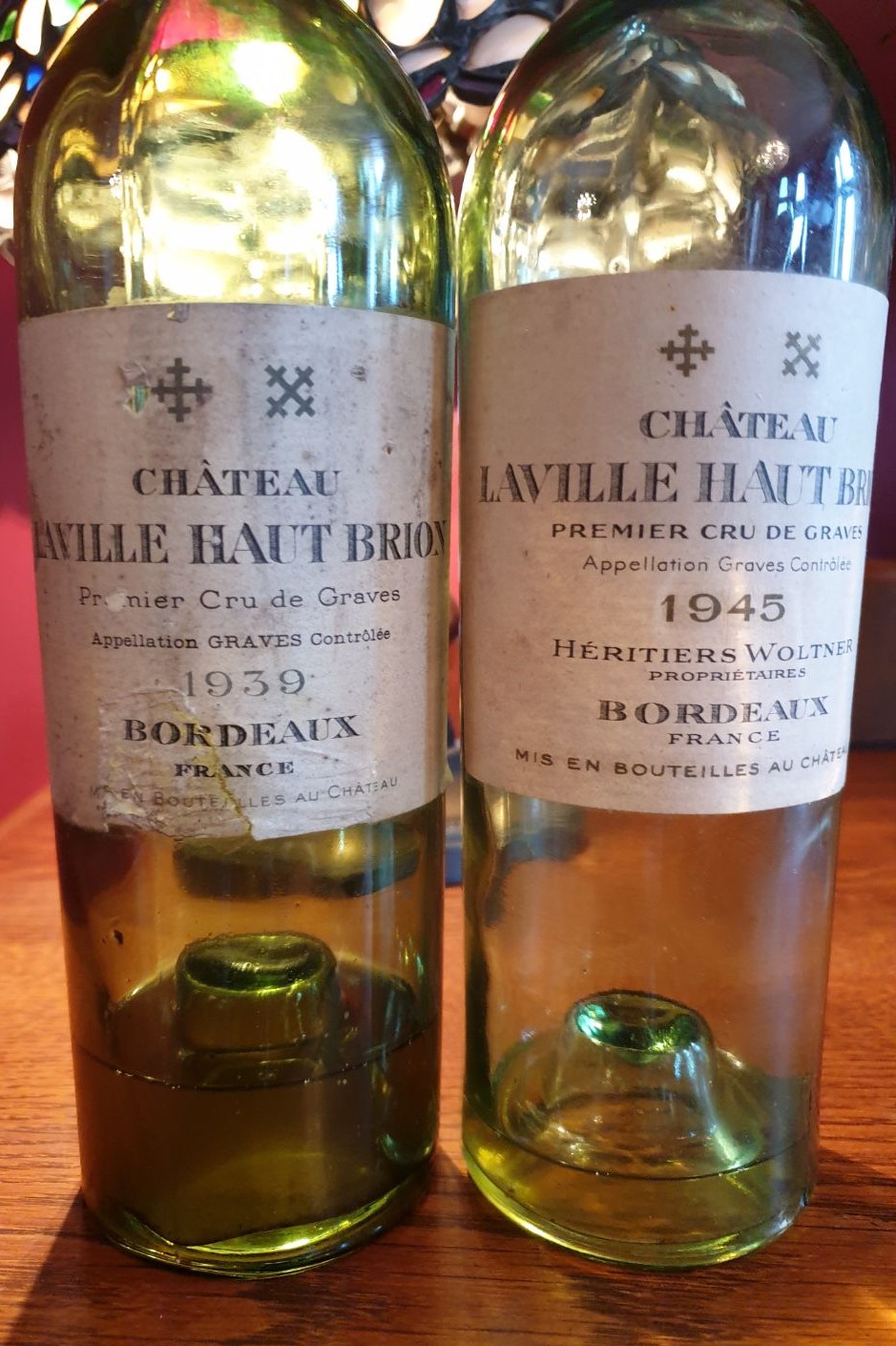
Flight two:
Leoville Barton 1940 - fresh cherry nose, still spanking around, well-knitted, well-balanced, truffles, very complex, and with persistent finish. This badass wine’s kept astonishingly well! 95p.
Domaine de Chevalier (magnum) 1940 – rather old, extracted coffee beans, not a very good bottle, which peaked many years ago. 86p.
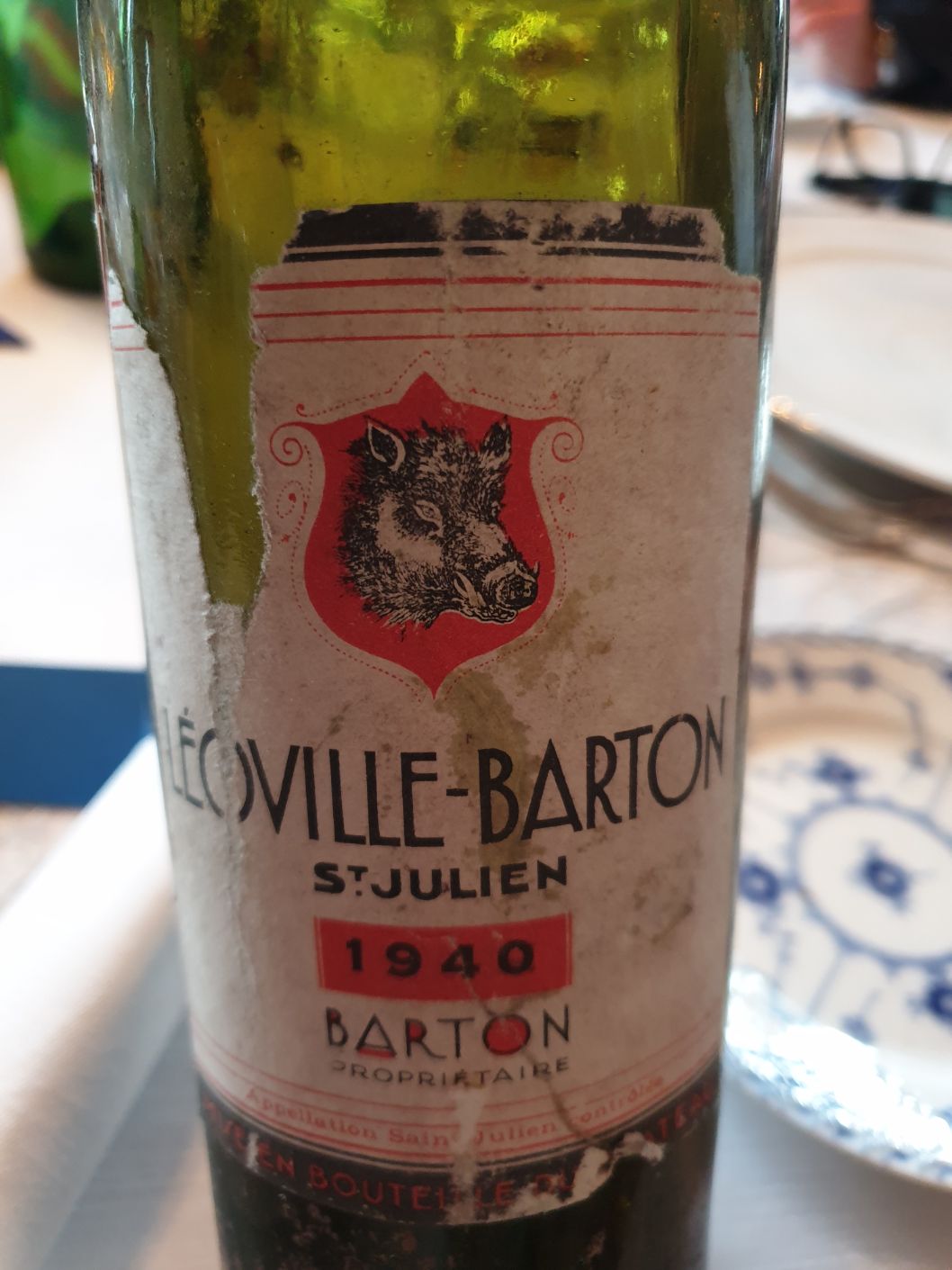
Flight three:
Leoville Barton (magnum) 1943 – again, an excellent display. Noble nose, aromatic cherries on the nose, and cherry taste. It's a well-preserved and elegant wine with some years left in the tank. 93p.
Bouscaut 1943 (dark horse) – a big surprise when the origin of this wine was revealed. I thought it came from Haut Medoc. There is a splendid concentration here, fine complexity, spicy cherries and blackcurrants, fine balance, and a persistent finish. It's not finished yet, and it's not bad at all! 93p.
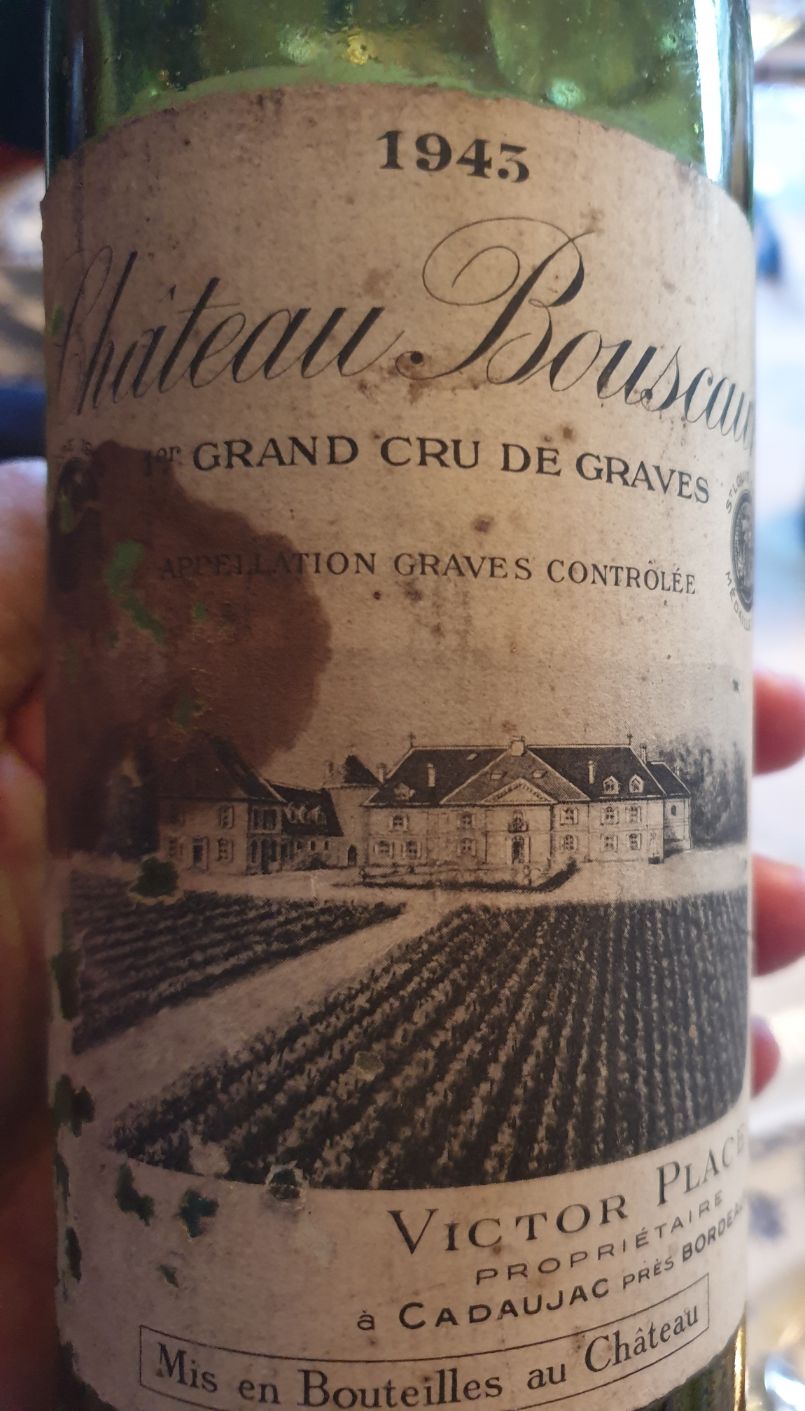
Flight four:
Lafite 1945 – at first sip, it was obvious that something superb from Haut Medoc was in the glass. Well-preserved cherries on the nose and palate, acidity was there and supported fruit in an exemplary way, pure elegance and sophisticated touch, great complexity, and lingering finish. Well-stored wine, for sure. 95p.
Latour 1945 was powerful, with a strong backbone and some volatile acidity, and its balance was out of order. For me, this wine tasted somewhat disjointed and very old. Maybe it suffered from improper storage. 88p.
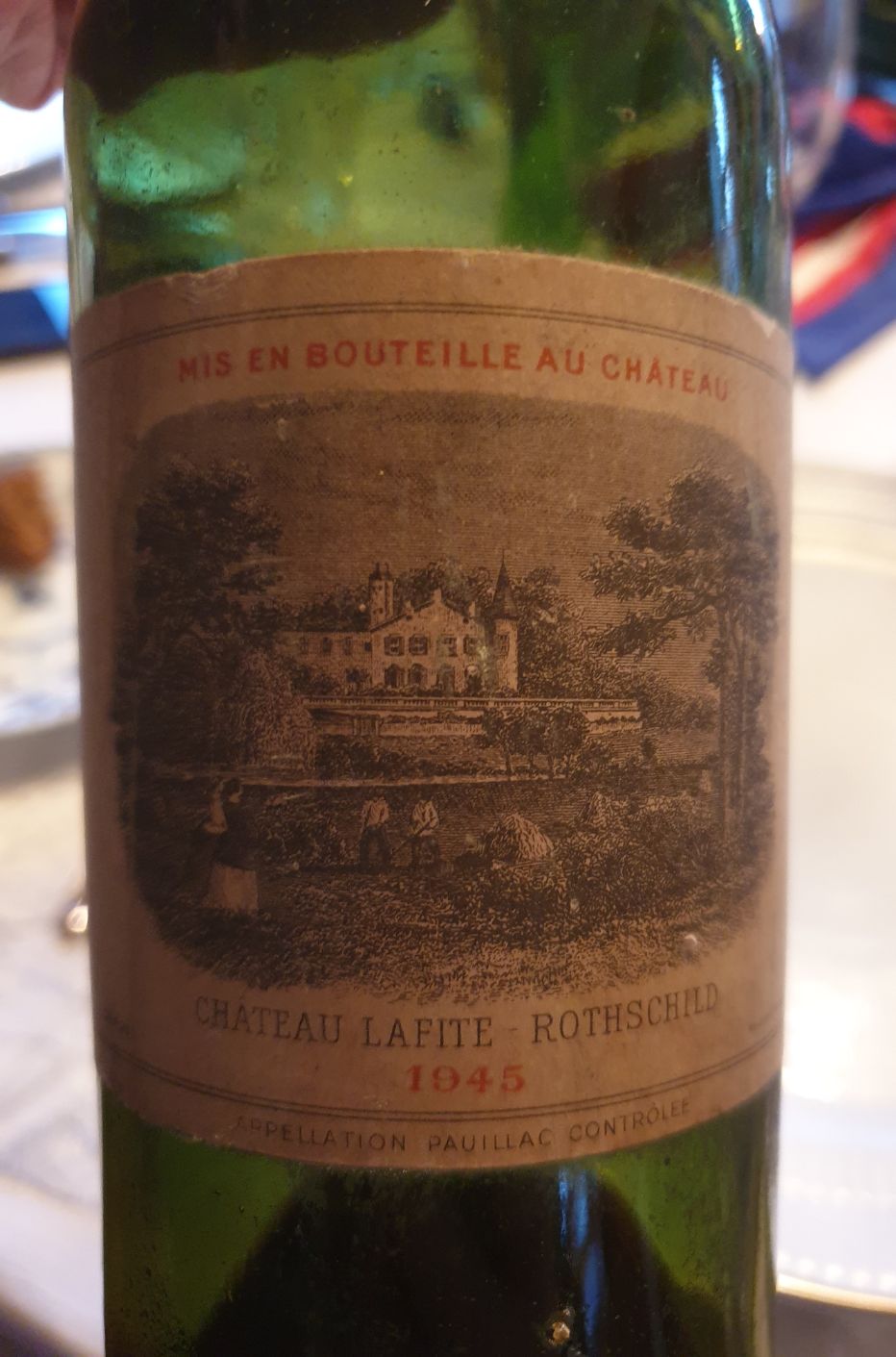
Flight five
Ch. Margaux 1945 – salty (oysters) on the nose, elegant, sophisticated, refined, and great length. It is still endearing and making wine tasters happier. 94p.
Haut Brion 1945 – old blackcurrant aroma on the nose, some truffles scent, much better on the palate with strong backbone and depth. The balance in this wine suffers a bit. Persistent finish. 92p.
Flight six
Corbin 1945 – young in color and appearance, unbelievable! Dignified cherry nose and sleek palate, sophisticated with great balance and sheer elegance. Great intensity of flavors. Smooth and lingering finish. It was simply an awesome experience. 96p.
Lanessan 1918 (dark horse) – for a 102-year-old wine, tasting it was a fine experience. It was still alive, fruity, round, and tasting well. Seeing old Bordeaux wine from lower ranks performing that well was impressive but surprising. 91p.
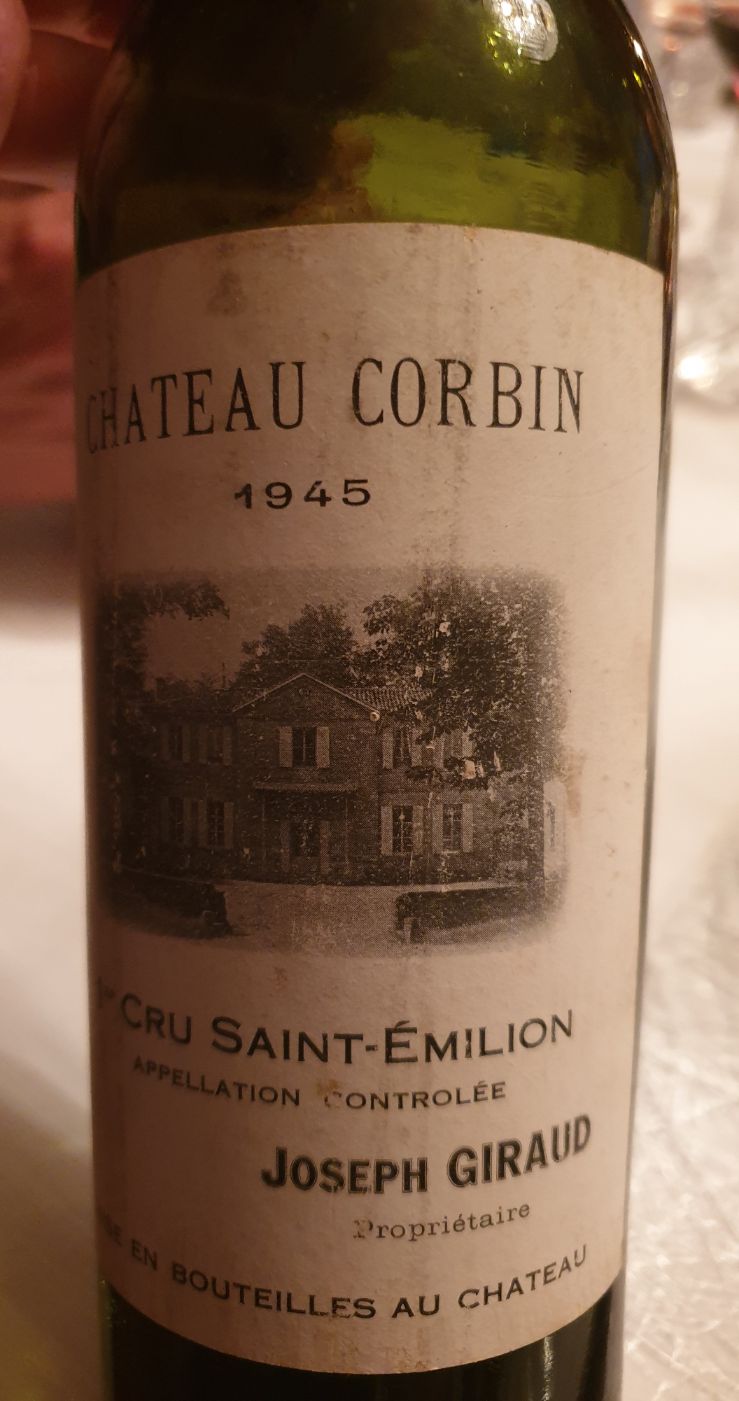
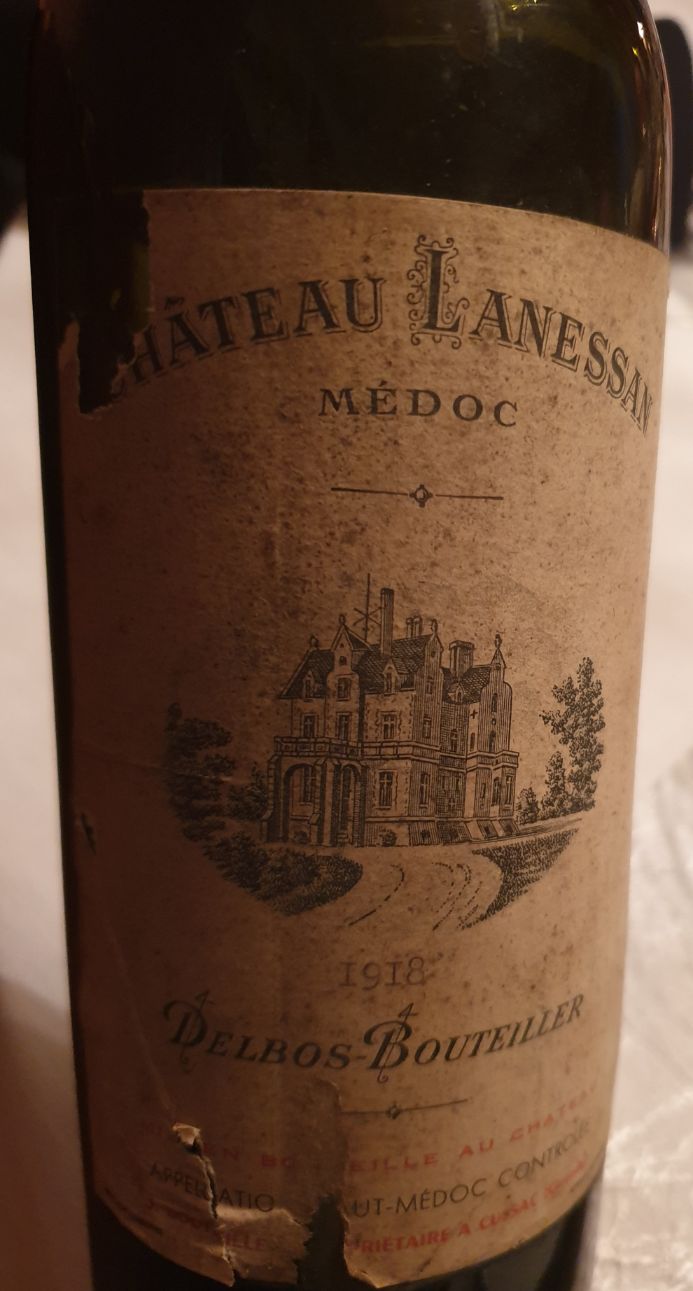
Flight seven:
Leoville Poyferre 1945 – well past its prime, a bit oxidized with sherry flavors, toffee, pleasant and round. 86p
Calon Segur (magnum) 1945 – in advanced age, with old aromas, some truffles, and decreasing fruit, I don’t believe this wine will last any longer. 2-3 more years, perhaps? 87p.
Flight eight:
Gruaud Larose (magnum) 1945 – dark-colored, sweet raspberry drops and truffles on the nose, well-balanced and tasty wine, smooth finish. 93p.
Talbot (magnum) 1945 – old flavors, the fruit was in a very advanced danger of disappearing, and the wine was getting volatile. 86p.
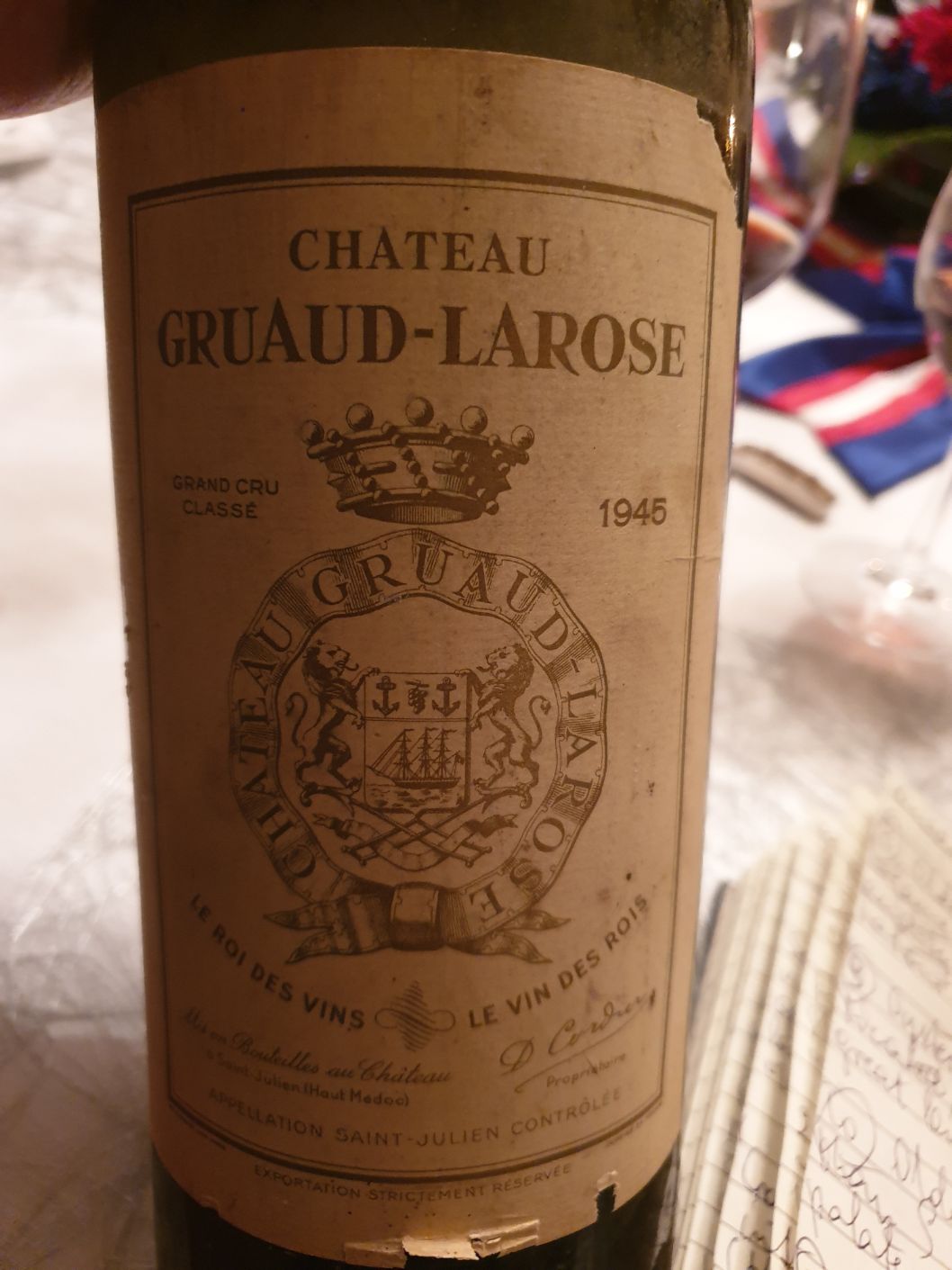
Dessert wine 1 – Caillou Crème de Tete 1943, Barsac – fresh with fine sweetness and corresponding acidity, an aroma of honey melon and guava, fine complexity, and creamy finish. Big surprise that this wine’s kept so well. 92p.
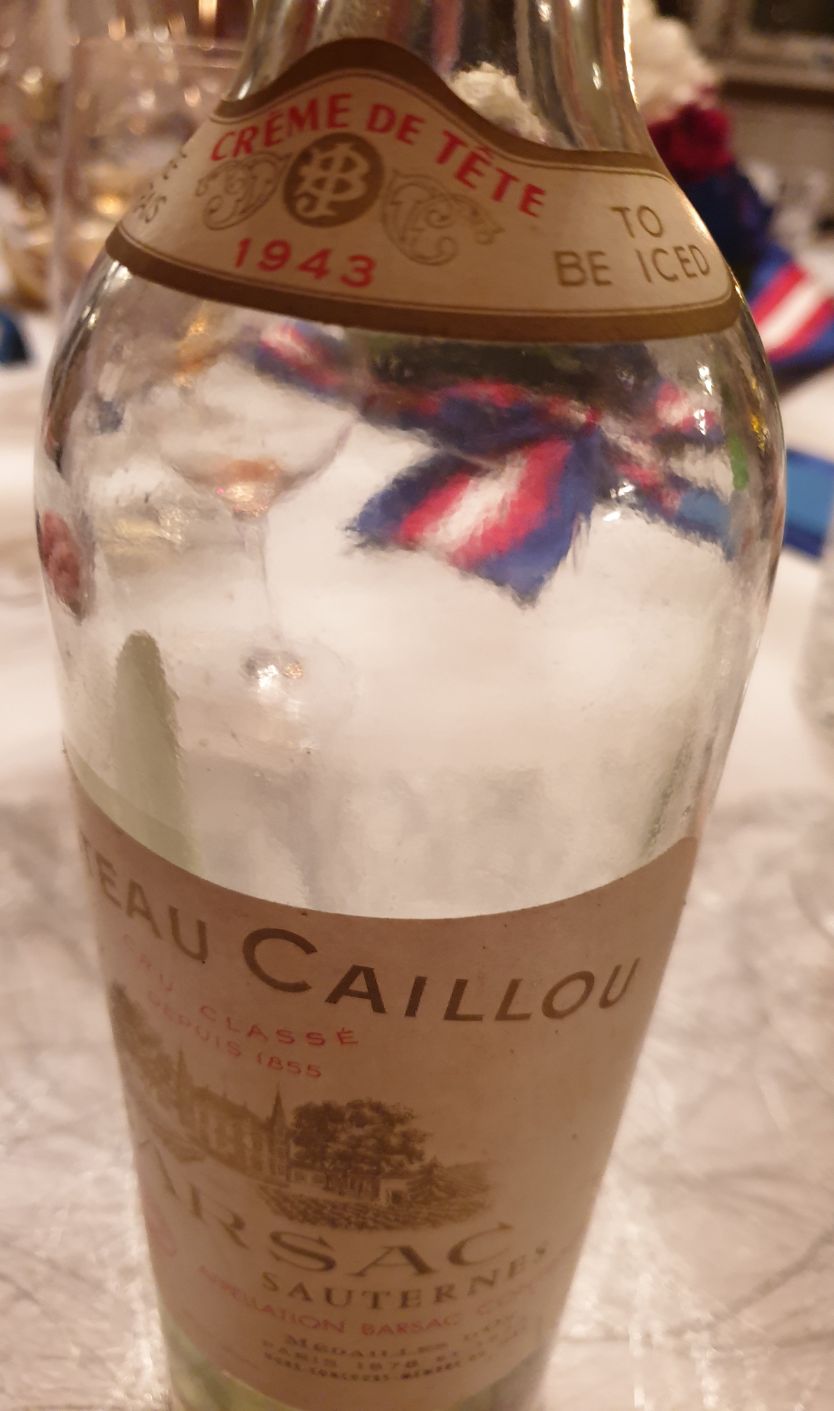
Dessert wine 2 – Croft’s vintage 1945 – still holding well, medium red with sweet cherries on the nose and palate, elegant with attractive sweetness and lingering finish. 92p.
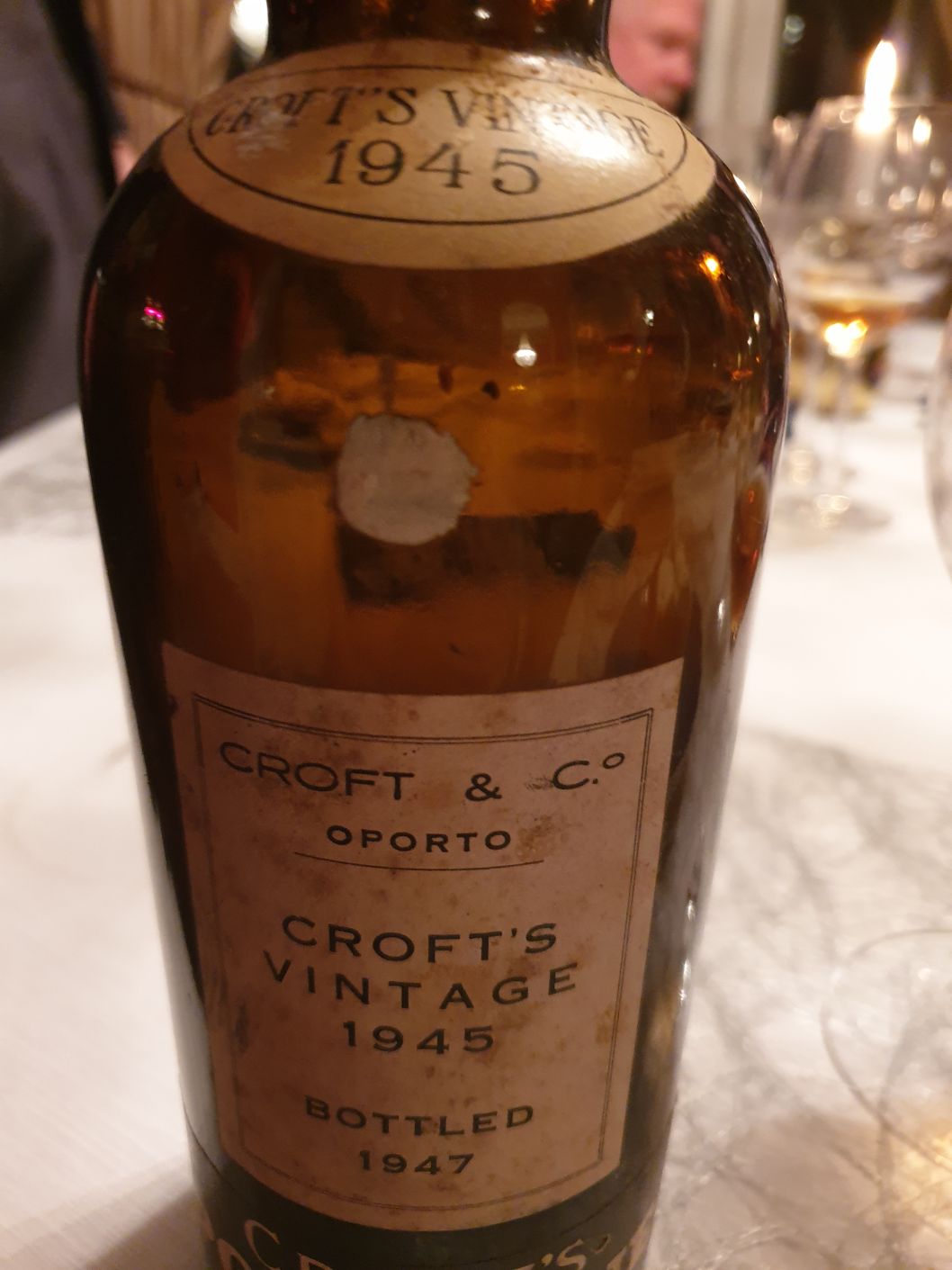
Dessert wine 3 – Smith Woodhouse 1977 vintage – black in color, very closed and unevolved. Dense and tight. After 43 years (May 2020), this port wine hasn’t opened its doors yet, and we probably have to wait for 10-15 years more. A fine future awaits. 94p.
Extras:
Bouscaut 1955 – has aged well, on the light side with elegance and finesse. It was a lovely and delightful wine. 91p.
Montrose (magnum) 1964 – I’d this wine several times before, and every time it was great. But the bottle here wasn’t a good one. Tired, musty aromas, acidity well in front, little fruit left. Improperly stored? 84p.
EXTRAORDINARY, SYMBOLIC, AND HISTORICAL TASTING OF 21 BORDEAUX WINES IN VINTAGE 1918 (20 REDS and 1 SWEET WHITE), 100 YEARS OLD IN COPENHAGEN, 11th NOVEMBER 2018
Women mainly made the 1918 vintage in Bordeaux, as men were heavily involved in the First World War, which officially ended with an Armistice agreement on November 11, 1918.
It was a vintage blessed by excellent weather conditions, a healthy growing season, and ripe grapes. Wines, for the most part, were very elegant, finessed, and refined, but they were also dark-colored, meaty, attractive, and full-bodied.
12 participants, including me, took a close look at this vintage in Copenhagen on the 2nd of November 2018. It was simply astonishing to experience how well several wines have aged. The top scorers aren’t finished yet!! Young and virile, that’s the statement. Bordeaux wines can age forever, can’t they?!
Big thanks to my friend Ivar Bjurner, who, with great enthusiasm, collected all these wines in Denmark and abroad.
My first 1918 was Chateau Citran, chateau-bottled from Haut Medoc in Bordeaux, which I tasted in April 2018 at Domaine de Chevalier. It was a very lovely, fruity wine. I rated it for 90p.
First flight:
1. Dark red, with a shoe cream smell on the nose that slowly dampens away from the glass. Nice on the palate, not edgy, fine balance, keeps well. Not bad at all for a 100-year-old wine! 92p. d’Armailhac. Chateau bottled.
2. It is cloudy and has lost its color. It is fishy on the palate and on its way to the wine graveyard. NR. Pavie. Chateau bottled.
3. Light red, old on the nose, like entering a room that hasn’t been opened for at least 50 years. It has a nice palate, light with some fruit left. How did this “little” wine survive the century?? 88p. Du Lyonnat, Lussac St.Emilion, chateau bottled.
Second flight:
1. Chocolate nose, aromatic, nice acidity on the palate, light with some elegance and pleasant taste. 90p. Leoville Las Cases. Chateau bottled.
2. A potent nose of black fruit, intense, thick on the palate, long, still fresh. Excellent balance and complexity. Smooth fruity finish. Vibrant and full of life. This is fabulous stuff! 96p. Beausejour (Duffau Lagarosse), chateau bottled.
3. Chemical nose, but a delicate and complex palate, fine acidity, and fat fruity finish. Still very much alive and kicking. 93p. Gruaud Larose Faure, chateau bottled.
Third flight:
1. The old and dusty smell of a closed room marks the palate. There is okay acidity, some fruit left, and a lovely aftertaste. Low stand. 90p. Lagrange, St. Julien. Chateau bottled.
2. Fresher on the nose than Lagrange, otherwise quite similar in appearance, more intensity, and length here. 92p. Pape Clement. Chateau bottled.
3. Wow! What a palate and length, intensity, and concentration! Virile, vibrant, and kicking-ass wine. Awesome stuff. 96p. Grand Puy Lacoste (stand C), Bordeaux negociant bottling.
Fourth flight:
1. Dark, intense nose with little tar scent, potent on the palate, long finish. 93p. Pichon Baron, DK-bottling.
2. Fresh on the nose, real bang on the palate, fine acidity, depth, complexity, and length. 95p. Pontet Canet, Eschenauer bottling.
3. Like Pontet Canet in terms of intensity, concentration, and length, it is dark and meaty with some truffle scent. 94p. Certan de May, Pomerol, chateau bottled.
Fifth flight:
1. Very old dusty nose, old sherry-like acidity, light, little fruit left. There is no excitement here. 87p. Chateau Margaux, chateau bottled.
2. More fruit here than in Chateau Margaux, fresher and younger, livid and kicking. It is just fine, well-balanced wine, pleasant and tasty. 92p. Mouton Rothschild. Chateau bottled.
Sixth flight:
1. This is very old stuff, similar to Chateau Margaux, maybe slightly fresher and younger in acidity. 89p. Lafite Rothschild. Chateau bottled.
2. Elegant and refined wine with delicate balance, intensity, and complexity. 91p. Haut Brion. Chateau bottled.
3. Very elegant and refined with a sophisticated touch. Light on the palate, and it tastes better than it smells. There’s nothing to be disappointed about here, as this wine still keeps well for its age. 92p. Cos d’Estournel. Chateau bottled.
Seventh flight:
1. Elegant with finesse, freshness, refined, gracious nose, silky texture, and velvety finish. Impressive for the age and the best wine of 1. Growths that particular evening. Amazing. 94p. Latour. Stand C. Chateau bottled.
2. Dark colour! It is elegant and gracious on the nose, strong on the palate, with big acidity and a long finish. It does not exactly show its age because it displays remarkable freshness and complexity. Young and kicking! This is a real badass wine! Calon Segur. 96p. Stand A/B. Chateau bottled.
3. Truffles. The wine was lightly textured and quite similar to Latour in appearance. 93p. Montrose. Stand A. Chateau bottled.
Climens 1918 Vandermeulen bottling rounded the tasting off. It was dark mahogany in color, much like vintage port wine, and tasted like that. 91p.
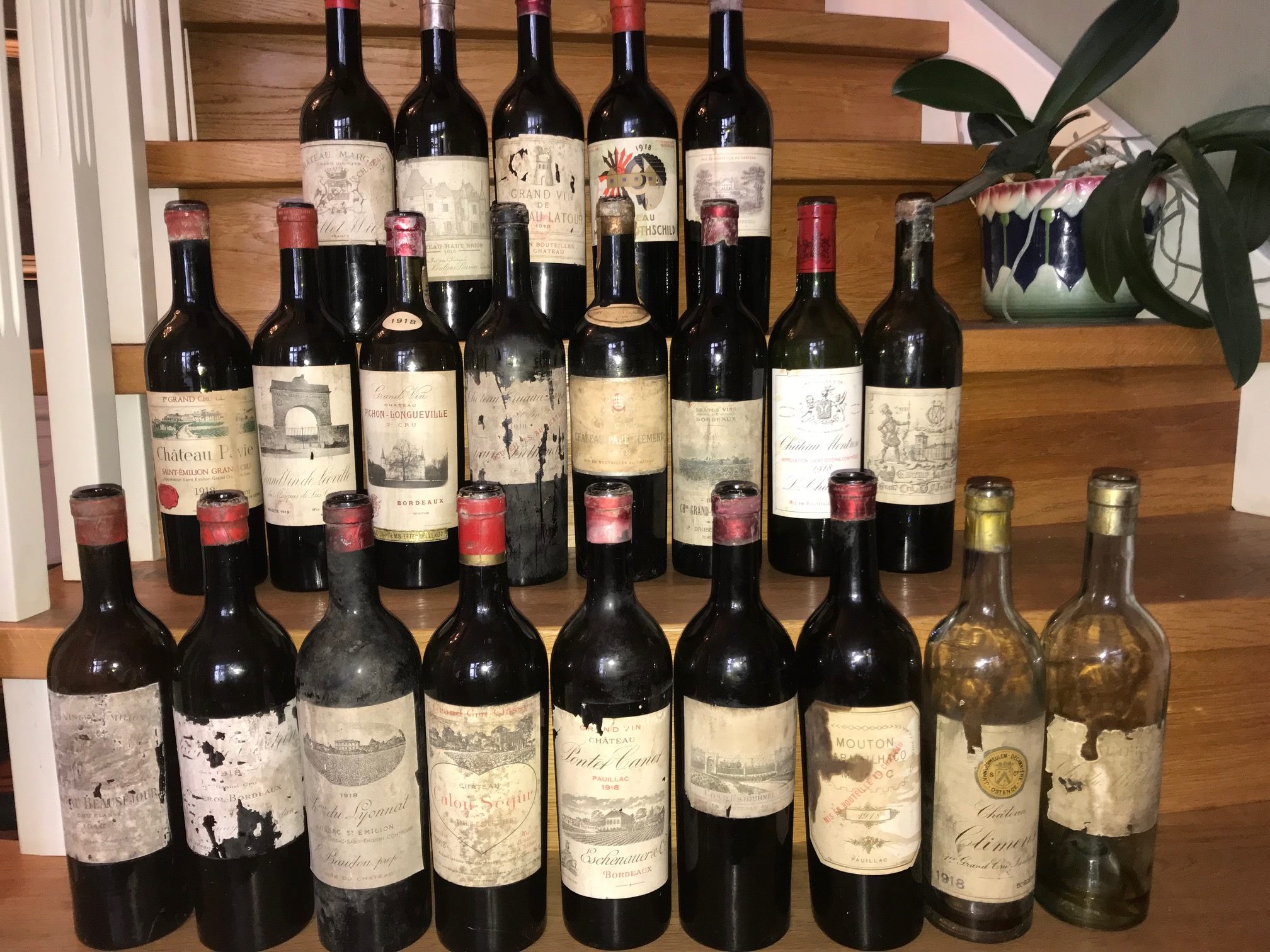
It's an awesome collection, isn't it?
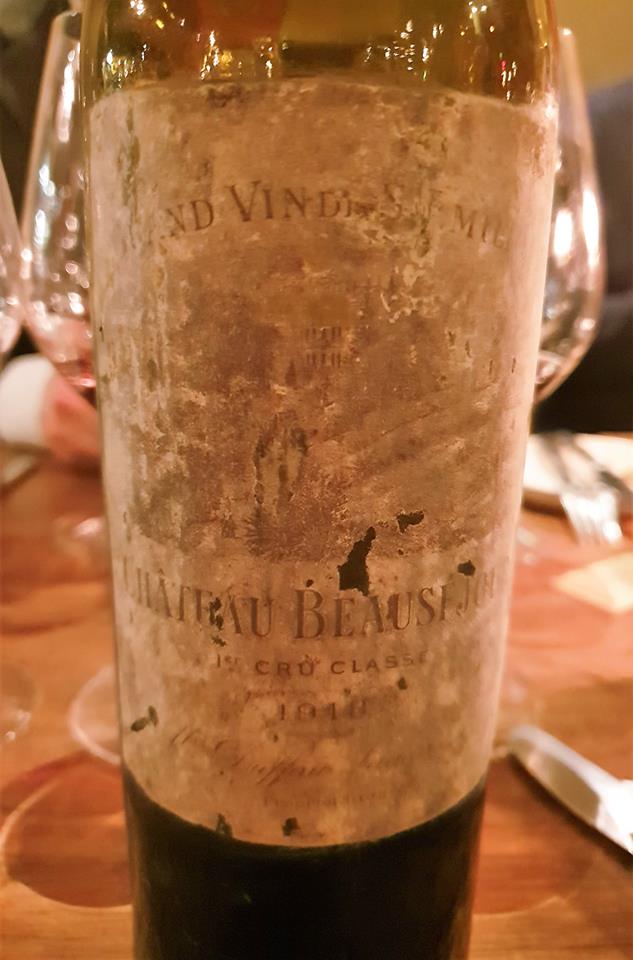
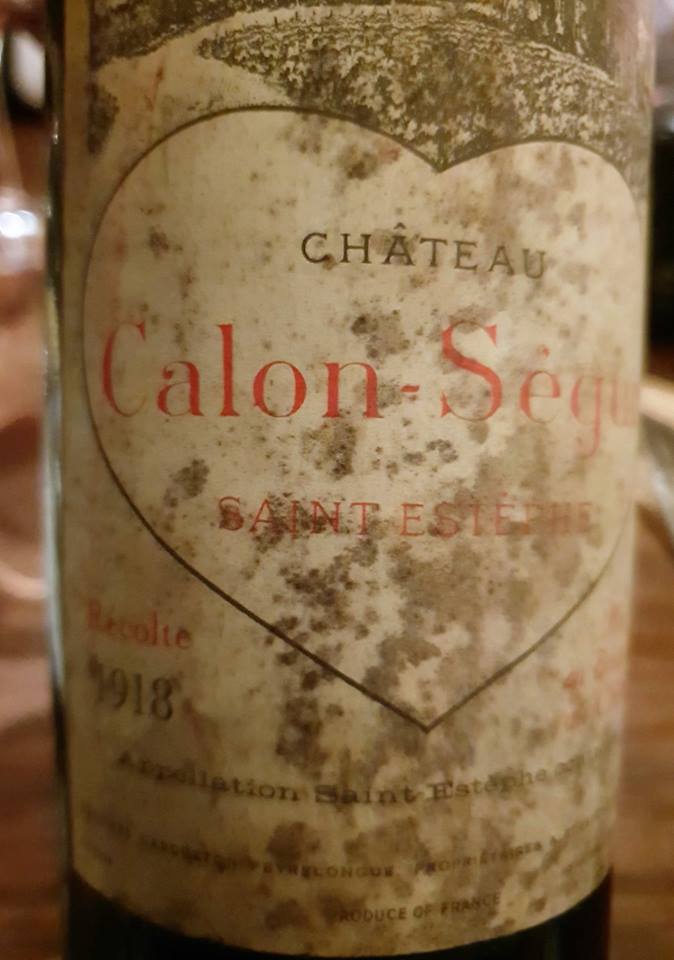
Two of three top scorers!
-----
VERTICAL TASTING OF COS D'ESTOURNEL IN COPENHAGEN - 29TH NOVEMBER 2017
I enjoyed an excellent tasting in the old wine merchant house in Copenhagen, Kjær & Sommerfeldt. It was perfectly conducted by a young wine consultant from that merchant, Niklas Bjergegaard Kristensen. Among recent vintages, my cherry pick was 2005. In my opinion, it was better than in 2009. Both are modern-style wines. 2006 and 2004 were splendid, 2007 light but round and well-balanced. 2003 didn't confirm the hype, and 2002 was corked. 1986 impressed me greatly, while 1955 was my wine of the day.
At the end of the tasting, Niklas went to the cellar and brought three wines we tasted blind. They were Montrose 1955 Danish bottling, Cos d'Estournel 1952 Danish bottling, and Montrose 1952. Cos 1952 was magnificent, with Montrose 1952 a little step behind. 1955 Montrose was fine old wine, truffy, elegant and well-balanced. Danish bottling here.
More descriptions and ratings of Cos d'Estournel wines - check it out in the "Chateau Profiles" chapter.
Ratings of Montrose´s wines
1955 - 92p
1952 - 95p
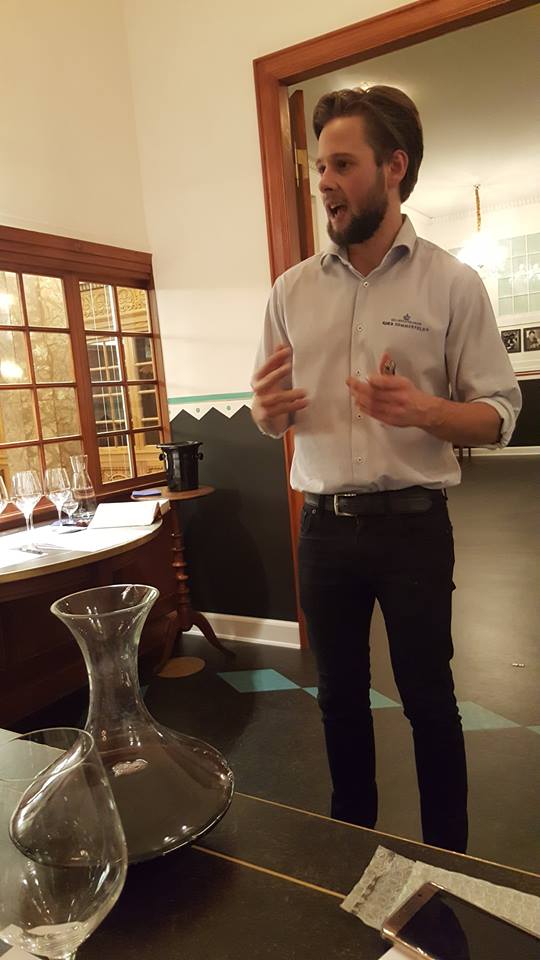
Niclas, who conducted the tasting
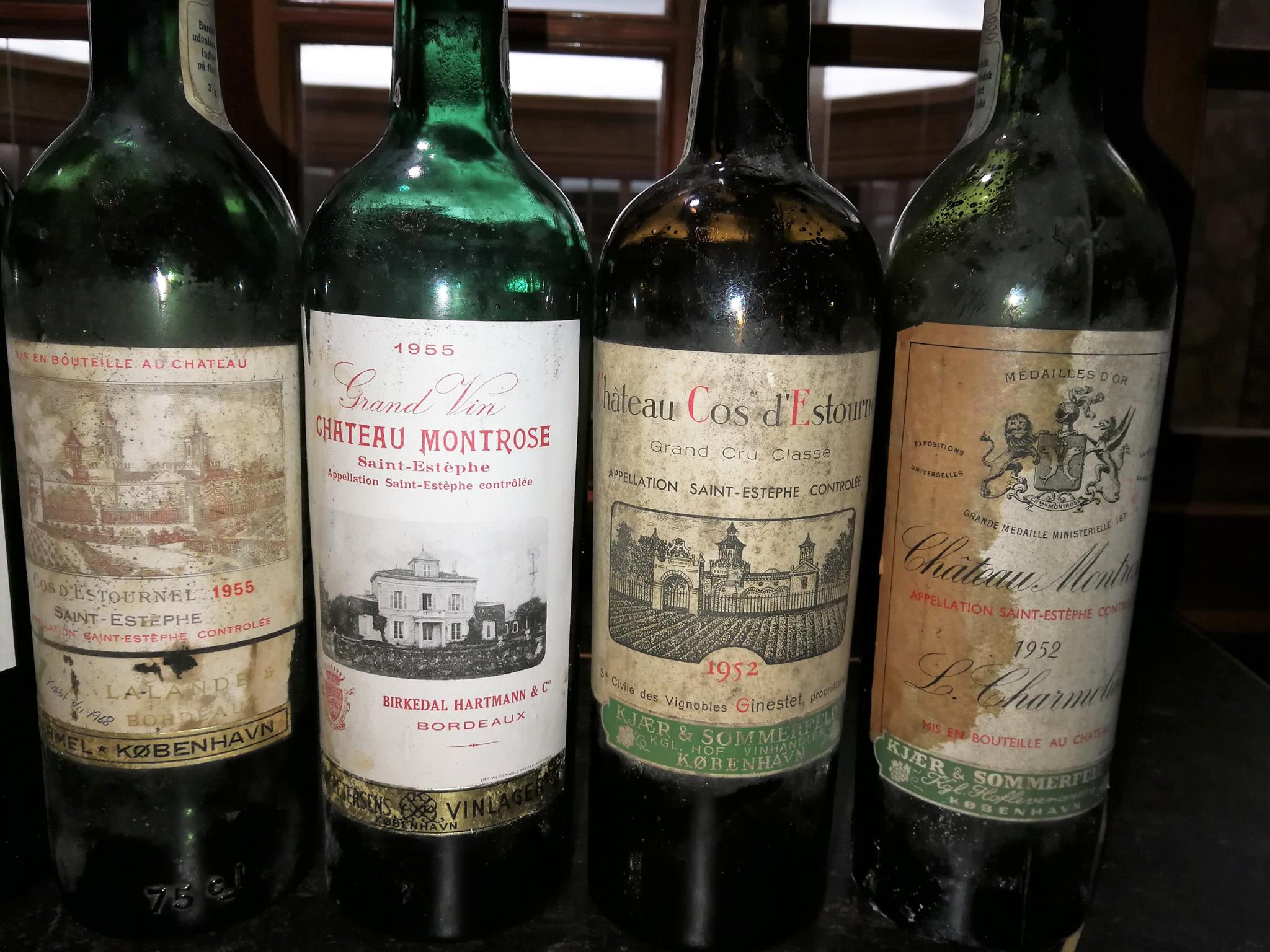
-----
MONTROSE TASTING IN COPENHAGEN ON THURSDAY THE 16TH JUNE 2016
One of my favorite Bordeaux wines visited Copenhagen on 16th June. Originally, Montrose's present technical director, Herve Berland, was supposed to conduct the tasting but had to cancel his arrival at the last moment. Montrose's sales manager, Lorraine Watrin, came instead and was a worthy replacement. I helped arrange this tasting with Commanderie de Bordeaux á Copenhague.
Wines for tasting and dinner were: 2010-9-5 La Dame de Montrose, 2012-2011-2010-2009-2005-2003-2000-1995 (magnum), 1970 and 1964 (latter - negociant Barriere bottling). Chateau donated 2010 and 2005 La Dame + 2012 Grand Vin. 2009 La Dame, 2011-2005-2000 Grand Vin also came from Montrose's cellar at reasonable prices. 2010, 2009, 2003, 1995, 1970, and 1964 were purchased from a Copenhagen wine merchant/private collector.
Montrose changed hands in 2004; the last vintage for the "old" cellar master was 2005. New people arrived in 2006. Jean-Bernard Delmas, father of Jean-Philippe Delmas (Haut Brion/La Mission), kept his position as technical director until 2011. Herve Berland, who spent five years at Mouton Rothschild as manager (2006-2011), became Montrose's technical director in April 2012.
Montrose is a force to be reckoned with, no doubt about it. 1. Growth quality in many vintages.
2010 La Dame de Montrose - great second wine and a clear indication of how stunning Grand Vin is because of selection! Perfect ripeness, fatness, dense and long. Silky texture and silky fruit/tannin. 92p.
2009 La Dame de Montrose - not as fat and sweet as 2010, spicy flavors, still splendid second wine. 89p.
2005 La Dame de Montrose - not far from the 2010 version, sweet fruit, silky fruit, and tannin, immensely seductive. Another winemaker. Simply splendid! 91p.
2012 Montrose - this wine is improving every time I taste it. It is very seductive, classy, distinguished juice, graphite, and toasted bacon again, with fine sweetness, acidity, and impressive structure and length. More women kiss on the cheek than a friendly punch on the face. Excellent for the vintage. 94p.
2011 Montrose - denser and tighter than 2012, but lacking the level of sweetness 2012 has, however, still very Montrose with splendid complexity, structure, and length. 93p.
2010 Montrose—I tasted it in pair with 2009. It was like meeting twins—this wine was an exact copy of 2009! The only difference is that it has more sweetness and a fatter texture. Velvety hammer worth 100p! One thing to remember—in 2010, ripeness inside and outside grapes happened at the same time, while in 2009, there was a ten-day difference because of rain in September.
2009 Montrose - thick, fat, dense, incredibly intense nose of blueberries, black cherries, and blackcurrants, stunning intensity on the palate, extremely powerful, stunning balance and length. Force of the winemaking. This wine is fully on the level with 1. Growths. 100p.
2005 Montrose - tasted in pair with 2003, and despite how I love 2005 vintage, I felt it couldn't compete with 2003. More elegance and finesse here, it is very seductive with a lot of sweetness, great balance, and a persistent finish. It is still an exceptional vintage for the property. 97p.
2003 Montrose - distinguished nose of leather, graphite, and roasted bacon. Very intense nose of blackcurrants, rich and sophisticated on the palate, with a robust backbone, exquisite balance, complexity, and staggering richness. No sign at all of the cooked and heated flavors, fresh and with an incredibly long finish. This is a fantastic tribute to the vintage! Kudos to the winemaker! 99-100p.
2000 Montrose - a great piece of winemaking, this wine was like a well-made cake, aromatic, beautifully constructed, polished, multi-layered, and incredibly complex. Maybe not as concentrated on the day as on how I tasted it last time (app. five years ago). 96+p.
1995 Montrose (magnum) - graphite and pencil, strong backbone, polished, fine structure and complexity, well-balanced and persistent finish. It's splendid for the vintage. 93p.
1970 Montrose - it had a significant flavor of graphite, earthy and polished, well-structured with splendid complexity, velvety texture, and long finish. It's much better than reviews on this vintage from other wine critics. 94p.
1964 Montrose - fishy, extracted coffee beans, light, nice fruit. Rather boring. 84p.
-----
THAT'S THE WAY TO CELEBRATE MY 70TH BIRTHDAY!
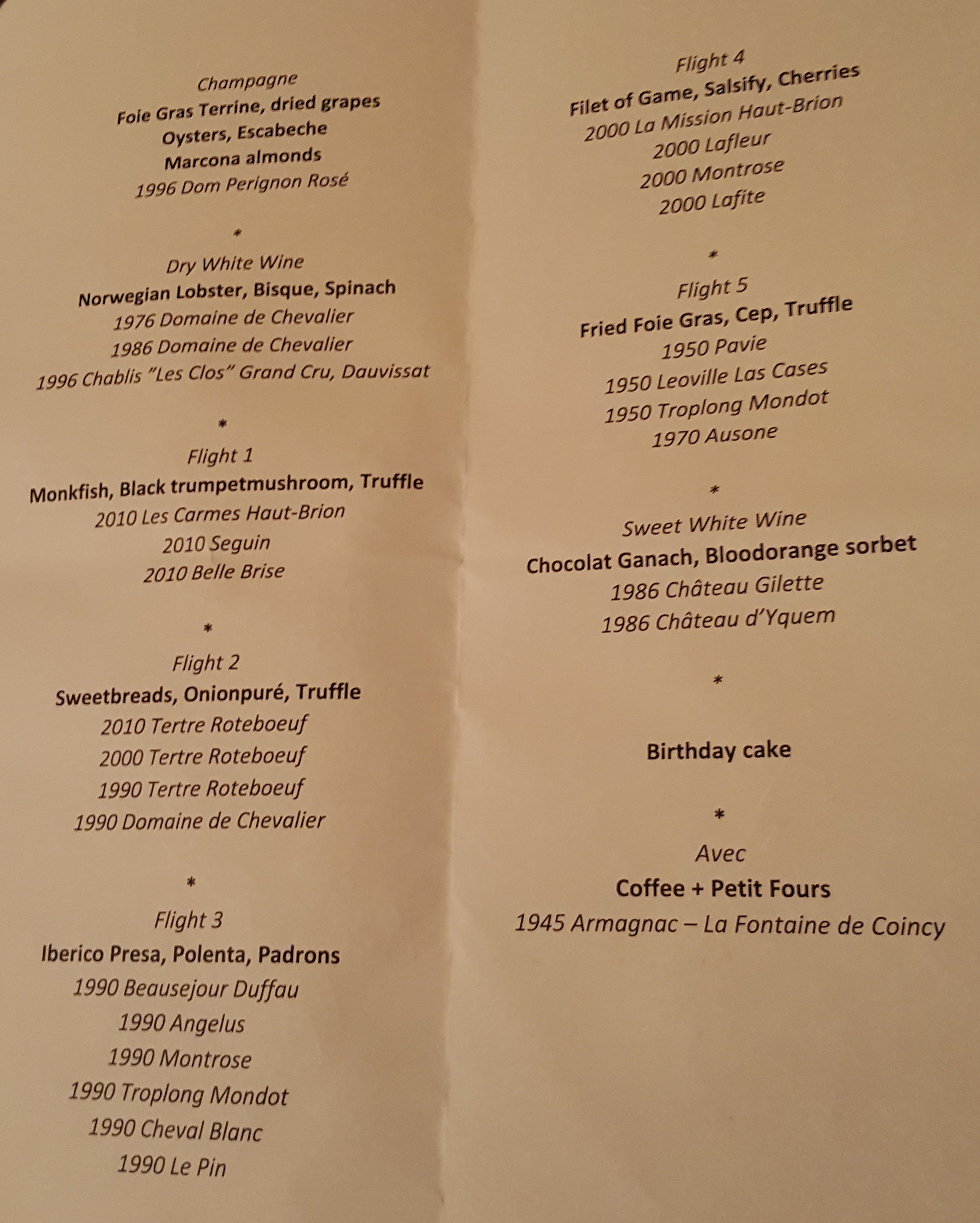
Menu and wines for this unforgettable evening/night!
On Friday, December 9th, 2016, at the restaurant Le Sommelier in Copenhagen's center, I held my pre-birthday party (I passed the 70th milestone of my life at the end of December 2016). I treated my friends and myself to 1 champagne, 3 dry white wines, 20 red wines, 2 sweet white wines, and one Armagnac, accompanied by appetizers, champagne, 6 courses, one dessert, and one birthday cake.
There were only 6 participants due to late cancellations from the people I invited. I immensely enjoyed the great company of Danish wine friends, my daughter, and Olivier Bernard from Domaine de Chevalier. We’ve had a stellar evening. Not a single wine served that evening was corked or oxidized. Many wines were simply stunning and lived fully up to their reputation and fame. All wines were tasted blind, and even I, who knew which wines were served in each flight, didn't see the order of these served. Wines were chosen according to the last digit in my birthday year (6) for whites (dry and sweet) and 0 for reds (as I celebrated 70 years). You will think it was outrageous to serve so many wines? - not in my honest opinion, you only live once!!

Chef Christian Marquard prepared excellent food, and young Daniela Mylin, chef/chef sommelier of Le Sommelier, handled the wines very professionally. It was a historic tasting and one I will never forget, thanks to my precious friends!!
Tasting notes – relatively short ones as I had to take care of my guests, and there wasn’t time to write big stories about each wine.
1. Champagne Dom Perignon Rose 1996 – imposing stuff, virile, sophisticated, rich, great acidity and sweet tones. Awesome to enjoy. 97p.
2. Dry whites – three wines. 1976 D.D.Chevalier had a little touch of oxidation, which disappeared quickly and showed nice acidity and concentration. Getting old. 89p.
1986 D.d. Chevalier was simply impressive stuff with great acidity, vitality, depth, and long aftertaste. It tasted young and fresh despite being 30 years old. 94p.
1996 Chablis Les Clos from Vincent Dauvissat had fine smoked tones of stones, a penetrating nose of melted butter, and a long aftertaste. A bit caught by age, and imho it’ll not improve. 93p.
3. Red flight 1 with the title “Up and running” – Les Carmes Haut Brion, Seguin, and Belle Brise, all in 2010 vintage. I’ve never tasted the two last-mentioned wines together, so it was a kind of test. L.C.H. Brion was muted, and light in concentration and structure. It was surprising when you took the quality of the 2010 vintage in general. Since the new manager/winemaker Guillaume Pouthier in 2012, the quality took a big step up. 89p.
Seguin from the village of Canejan in Pessac-Leognan AOC (my discovery while touring Graves/Pessac Leognan in September 2010) had an intense nose of cherries, excellent structure and depth, exquisite balance, and long persistent finish. Utterly impressive stuff. 95p.
The last wine on the flight was Belle Brise from Pomerol, also my discovery, but only since 1996. This minuscule vineyard/garden is situated very close to Libourne. Strong with modern taste, very cherry, catching sweetness of fruit and tannin, silky fruit and tannin. Long and persistent finish. Fabulous wine. 95+p. The owner doesn't have a consulting oenologist, and there are no modern winemaking remedies here - he makes “vin au naturel”!

4. Red flight 2 with title “Magic” – Tertre Roteboeuf 2010-2000-1990 and Domaine de Chevalier 1990. 2010 TR tasted more like kirsch than wine, but I’m pretty sure the alcohol will soon integrate. Otherwise, it was big wine, packed with silky fruit and tannin, immensely flavored, and long. 96p. 2000 TR was epic wine with an intense nose of truffles, formidable structure and depth, stunning precision, focus and complexity, and mega long aftertaste. Boom! 98p. 1990 TR tasted lighter and less impressive than the last time (in 2011) and was surpassed by the 2000 version. 92p.
1990 D.d. Chevalier (“black horse” quickly detected by tasters) showed a truffy nose, delicious complexity, and perfect length. The fruit tasted a bit warm. 89p.
5. Red flight 3 with the title “Sky is the limit" and six wines in 1990 vintage. Beausejour Duffau was kind of disappointing if you take its fame in context. One of my guests tasted this wine many times and told me it was much better 10 years ago. Fine complexity but not striking concentration and richness. 93p.
Angelus didn’t hit the bull’s eye either. It was better, too, 10 years ago. It had a truffy scent and wasn't as powerful, rich and long as expected. 93p.
Montrose once again delivered. It’s easy to fall on your knees and worship this wine because it’s a phenomenal masterpiece of winemaking. 100p.
Troplong Mondot was a stunning mouthful, with everything in perfect harmony. One of my guests said to me that this wine was disguised as a port. Frankly, I didn’t care. I loved it! 97p.
Cheval Blanc matched Montrose to a great extent, with Cabernet Franc at full blossom. Fascinating and riveting display of richness, sophisticated touch, and variety of flavors. 99-100p.
Le Pin was more kinky and funky than Cheval Blanc but equal in every aspect to it. Here, Merlot was the showcase. 99-100p.

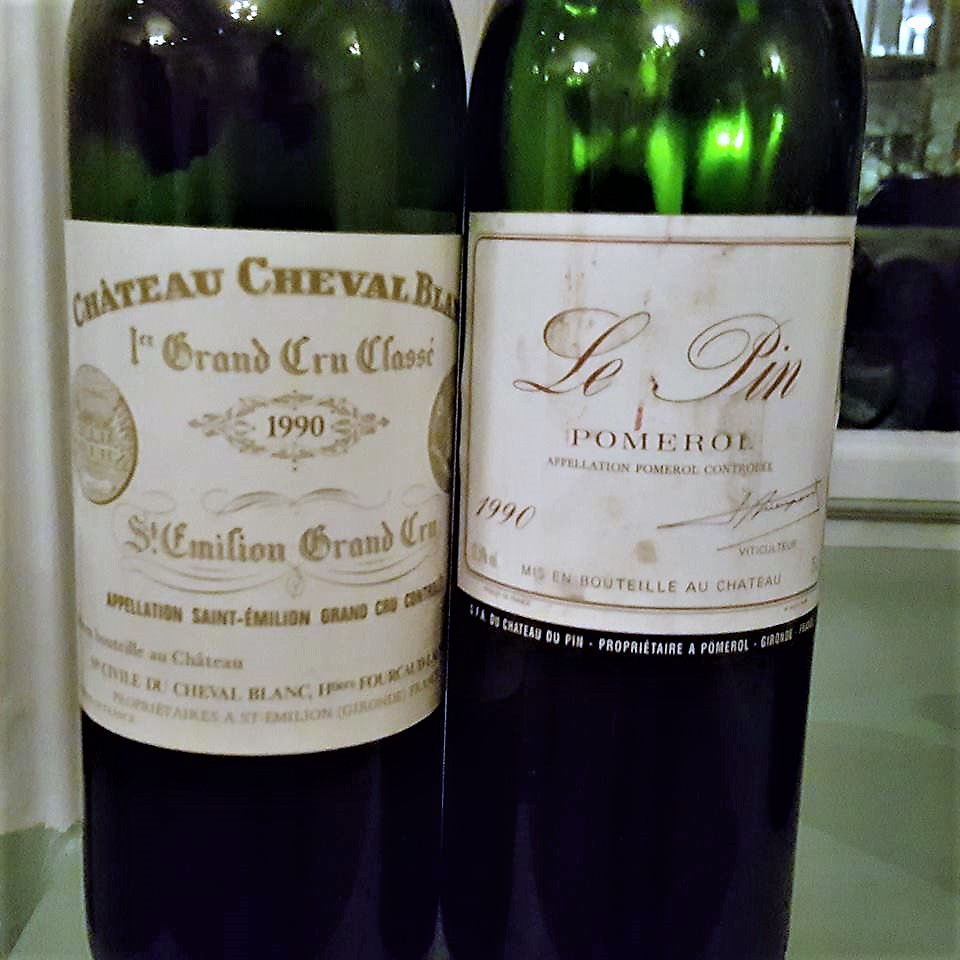
6. Red flight 4 with the title "Another day in paradise" and four wines in 2000 vintage. La Mission Haut Brion tasted closed, but all cylinders were fully loaded, just waiting for the perfect time to show all the fabulous things. Patience required. 96-98p.
Lafleur was just a timeless treat, so dense, so sophisticated. Paradise! 100p.
Montrose tried to match up against big hitters here but wasn’t trashed at all. Strong potent and very long finish. 96p.
Lafite is just the perfect sip if you want to enjoy finesse, grace, and richness of nuances. That was exactly what we had in 2000, plus striking structure, depth, and balance. 99p.
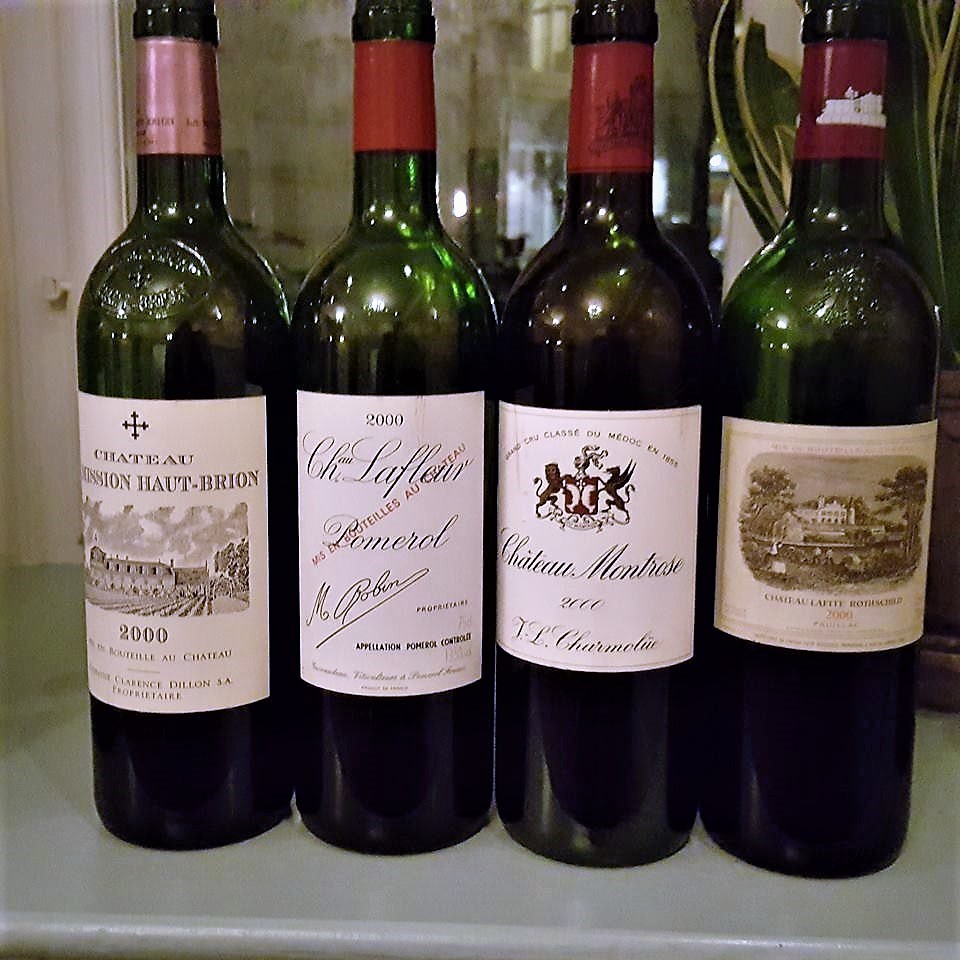
7. Red flight 5 titled “As time goes by” and three wines in 1950 vintage, all chateau bottled. Pavie (B-niveau) was just awesome, like a well-trained 66-year-old running a marathon. It was very cherry, strong, long, and in perfect balance. Still, many years to go! Some of my guests took it for the 1982 vintage! 94p.
Leoville Las Cases, the one with the lowest stand, tasted old, like extracted coffee beans. Gone. 75p.
Troplong Mondot, despite its low stand close to C, made by a cousin of the owner of Pavie at that time, Valette, was as similar and impressive as Pavie. 94p. 1970 Ausone was withdrawn before the flight as I realized that it'd be better to keep 100% focus on three wines in the same vintage.

8. Sweet whites – two wines in 1986 vintage. Gilette had a significant flavor of almonds, great sweetness and acidity, great depth and backbone, and was long and velvety on the palate with a strong and fat finish. Aged for 20 years in small concrete vats, and there were no wooden vats/barrels for aging. 96-97 p. Yquem edged Gilette in terms of depth, sophisticated touch, and nuance richness, but only and just that. 98p.
9. Dinner finished with awesome 1945 vintage Armagnac “Fontaine de Coincy”, same owner as previously mentioned Belle Brise in Pomerol. De Coincy family has owned their property in Bas Armagnac for 400 years.
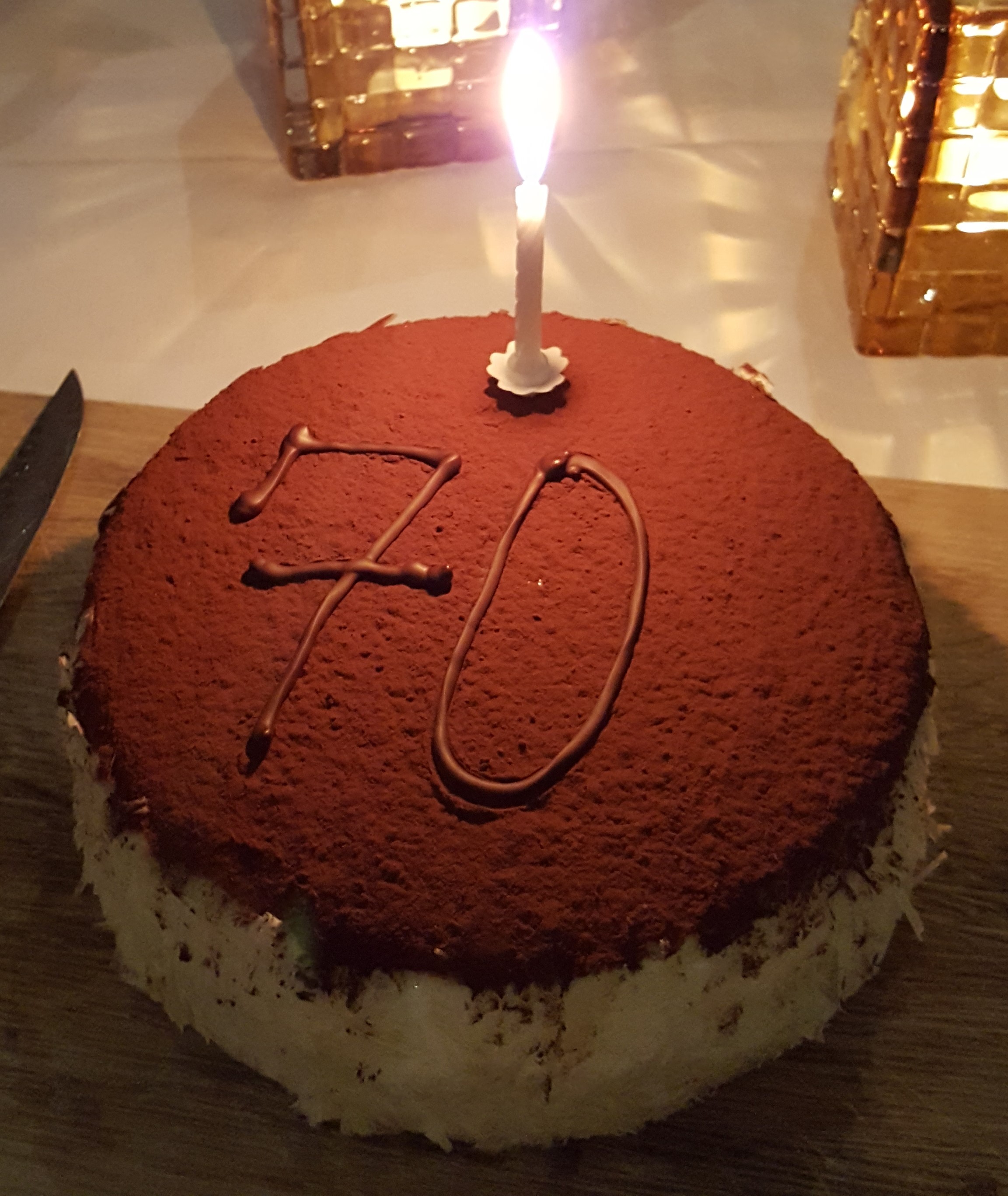
-----
BORDEAUX 1985 REVISITED ON 26TH NOVEMBER 2015
On Thursday, November 26th, 2015, 11 experienced wine tasters gathered at Restaurationen, a classic French-Danish restaurant in Copenhagen, to taste 16 wines from the 1985 vintage, including 5 1. Growths from Left Bank, 1 PGCC A from St. Emilion named Cheval Blanc, and 6 2. Cru Classes from Haut Medoc.
I was overseeing harvest (my first ever) in September 1985. It was my second visit to Bordeaux (the first one occurred in March 1984 in terrible rainy weather). Throughout the two weeks I spent in September, I was treated to beautiful weather, sunshine from morning to evening, and 27 degrees Celsius. Very few properties had thermoregulated vats; many others used ice blocks to cool the must from outside.
One of the main reasons I remember the 1985 vintage is because I unexpectedly met Jacques Thienpont of Le Pin in September 1985 while on my way to Cheval Blanc. Instead of going straight for about 500 meters and then turning right, I mistakenly turned left after leaving the hamlet of Catusseau. After walking for a while, I encountered a man standing in front of a small house. I asked him for directions to Cheval Blanc, and he kindly explained how to reach it.
I also remember eating over half a kilo of big, fat, juicy, sweet Merlot grapes at La Dominique.
Many wine critics call this vintage a woman's vintage because of the wine's seductive approach, great sweetness and balance, elegance and charm. I completely agree. One must remember that 1985 produced an enormous amount of wine, with yields between 60 and 70 hl/ha at many famous places. There was no green harvest, no leaf removal. It's a remarkable vintage in many ways, as my TNs show! It's aged beautifully for 30 years and has been an open-arms vintage from the very beginning. Classic Bordeaux at large!
The tasting:
Tattinger Comtes de Champagne Blanc de Blancs 2005 – fresh with fine acidity, citrus, rich and refined with finesse and sophisticated touch. Long finish. 95p.
Rausan Segla 2. Cru Classe Margaux – light red, fabulous on the nose with the typical aromatic scent of Margaux commune, black cherries, a lot of sweetness, truffy with sheer elegance and finesse. It was classy wine and still going strong. I didn’t expect this wine to be that excellent – there’s for sure at least ten years more life in it! 94p.
Leoville Barton 2. Cru Classe St. Julien – much darker in color, powerful, blackberry/blueberry compote, strong tannin to support the fruit, barely so elegant and finesse marked as RS, but this wine is a beast. It will probably keep like that without any problems for another 20 years. 95p.
Gruaud Larose 2. Cru Classe St. Julien – fabulous thick layered nose of blueberries, fine acidity, truffles, fine-grained tannin, great balance, depth, and finish. It is as excellent as Leoville Barton but has a different style, and I think it won’t keep as long as Leoville Barton. 95p.
Leoville Lascases 2. Cru Classe St. Julien is powerful, and it reminded me a lot of Gruaud Larose, but it lacked sweetness and length. 93p.
Cos d’Estournel 2 Cru Classe St. Estephe – yogurt, strong, spicy with truffles, sappy, big structure and backbone, great balance, depth, and length. Mother….. of a wine, give it 20+ years more! 96p.
Blind wine – everybody guessed Bordeaux. It turned out to be 1985 Dunn Vineyards from Napa. I guessed Calon Segur. Pepper, strong tannin, strong structure and depth, meaty finish. This excellent wine still has 10-15 years to go. 95p.
Pichon Comtesse 2. Cru Classe Pauillac is extremely seductive on the nose, charming, truffy, and intense. There is a lot of sweetness, great balance, silky fruit and tannin, and a long aftertaste. In full blossom, and what a treat!! I simply adored it. Sure bet for 15 years more in the cellar. 96p.
Lynch Bages 5. Cru Classe Pauillac – rawer and more powerful, with great complexity to start with, but after 20 minutes in the glass, this wine falls apart for some reason. 92p?
Then five 1. Growths served in one flight:
Haut Brion – aromatic and complex nose of blackcurrants, very stylish, excellent sweetness, truffles, great balance, silky fruit, and tannin. 20 more years? Impressive stuff. 96p.
Margaux – already tasted twice in 2015 with the same impression. I don’t think this wine offers tasters much in terms of aroma, depth, structure, and sweetness. It’s light but also round and charming. 90p.
Mouton Rothschild – distinguished and classy stuff, wealthy and refined, sophisticated, truffles, fabulous structure and depth. Bull’s eye! Easily holds an additional 20 years in the cellar. 97p.
Lafite – powerful, deep, and strong, with lots of fruit and tannin, perfect balance, and a big meaty aftertaste. Not as distinguished as Mouton Rothschild, but who cares? There are many years to go. 96p.
Latour here was a bit light and not up to Mouton Rothschild and Lafite's quality and excitement level. Still, it isn’t a bad wine, just gracious, seductive and tasty. 92p.
Then, two wines from Right Bank:
La Conseillante Pomerol – anonymous, light, round, and pleasant. Just Ok, wine. 88p.
Cheval Blanc PGCC “A” St.Emilion – showing some age, truffles, refined and elegant with finesse. It is a stylish wine that tastes extremely good. Excellent. 95p.
We finished with:
1985 La Tour Blanche – this vintage wasn’t memorable in Sauternes and Barsac because of the lack of botrytis caused by lack of rain. The sweetness in wines resulted more from grapes drying out because of the heat. This wine was served from a double magnum and was just OK. 87p.

-----
Great evening in Copenhagen on Thursday, May 30th, 2013, with 16 2010s and three 1990s Bordeaux wines.
Last Thursday, I was one of 16 tasters to participate in a tasting of fifteen 2010s and drink one 2010 white and three 1990s for the following dinner at the restaurant Le Sommelier in the center of Copenhagen.
It was an exceptional showing of 2010s boarding for some wines to be perfect/fantastic. Almost all these wines have improved since I tasted them from the barrel. I've also tasted around 20 2010s at several properties. I'll make a statement that this is a fantastic vintage, which imho surpasses 2009 in terms of ripeness of fruit and tannin, complexity, and richness.
In particular, the tannins of 2010 were fatter and riper than in 2009. You can't even taste tannin in many wines as it's packed in velvet. There's evident alcohol in a few wines in the nose and palate, but most 2010s aren't showing it. The balance of 2010 is extraordinary and will allow the best wines to be kept for at least half a century. I'm not convinced that the 2009 vintage can stay as long.
1st flight - Saint-Emilion and Pomerol:
1. Trottevieille– dark color, the great aroma of black cherries/raspberries/blueberries and chocolate, intense on the nose, the big concentration of sweet fruit and fat tannin, perfect ripeness and long aftertaste, classy and complex wine with great balance. It's an excellent example of keeping traditional winemaking intact and not overdoing it with some modern gimmicks. Great success for the property! 95p.
2. Troplong Mondot – very intense nose of black cherries/kirsch, you can feel the alcohol on the nose and palate, a hefty dose of new oak balanced by perfectly ripe fruit, obvious modern style with a maximum of everything. It's a bit overdone. Long-time runner – I believe it'll start to soften in ten years. 96p.
3. L'Evangile – an excellent intensity of black cherries, grated chocolate, cocoa powder, truffles (iron oxide), very dense and precise, tight and fat on the palate, perfect ripeness of fruit and tannin, long, long finish that lasts for 1 minute. Exceptional stuff. 98p.
4. VCC - simply fantastic with a sublime nose of chocolate mixed with beautiful black cherries, violets, silky palate filled with black cherries, astonishing richness, balance, and structure. I believe this wine easily edges the 2009 vintage. 99-100p.
2nd flight – Margaux and Péssac Leognan:
1. Giscours – fabulously aromatic nose full of blackberries intermixed with chocolate and cocoa powder, seductive, stylish, complex, fabulous sweetness, fatness, stunning length, balance, and structure. It is an awesome wine with great class, finesse, and a sophisticated touch, so typical for Margaux commune. 95-96p.
2. Palmer – incredibly scented nose and palate, black cherries and Valrhona chocolate everywhere, awesome complexity structure and length, fat fruit, and tannin on the palate. It is a very sophisticated wine with both power and extreme elegance. Heavenly stuff. 99p.
3. Haut Bailly – probably the weakest 2010 tasted during our evening. Intense black fruit on the nose and palate, fine balance and length. Lacks the fatness, tightness, depth, and concentration found in many other wines in this vintage. I wonder if the yield here was too high. 92-93p.
4. La Mission Haut Brion – velvet and silk everywhere, extremely intense on the nose and powerful on the palate, incredibly sophisticated, with fantastic complexity, structure, and length. The aftertaste lasted for 2 minutes. Sheer class and style. This wine has evolved perfectly since I tasted it from the barrel in March 2011. Paradise in heaven! 100p.
3rd flight – Saint Julien and Saint-Estephe:
1. Gruaud Larose – yet again and again, I've to use the word black cherries/blueberries/blackberries to describe the nose of this wine. It is the trademark of this vintage. There is a great sweetness of fruit, which is very concentrated on the palate, with great complexity, depth, and length. Splendid wine for the vintage. 94p.
2. Leoville Poyferre – more of everything than in Gruaud Larose, the modern style here, packed with perfectly ripe fruit, fabulous intensity, and concentration. Fabulous structure and complexity. Perfect balance. It is a stunningly impressive wine. 97p.
3. Cos d'Estournel – black fruit en masse and alcohol (cherry vodka) very evident on the nose and palate, extremely powerful on the palate with really fat fruit and tannin. The fruit is on the border of over-extraction, and this wine is extremely massive and, imho not typical of Bordeaux. Closer to Napa Valley style. Either you like it, or you hate it. I'm neutral, and you can't abstract from the fact that this is high-quality wine. 96p.
4. Montrose – simply monster wine with its thick aroma of black fruit, enormous concentration, robust backbone, perfectly ripe fat fruit, fat tannin, stunning complexity and structure, and impeccable balance. Incredibly stylish 2010 and showing 100% what this vintage has to offer. Mind-boggling effort. 98-99p. I also tasted it in April 2013 at the property with the same impression.
4th flight – Pauillac
1. Batailley – intense nose of black cherries and blackcurrants, splendid balance, sweet fruit and tannin, powerful palate, fine complexity and structure, long fruity aftertaste. Splendid effort. 94p.
2. Pichon Baron – a thick layer of fruit and tannin, perfectly ripe, sophisticated, and stylish, the fabulous richness of nuances, depth, and length. Robust backbone and impressive structure. It's a stunningly long finish. This is awesome stuff. 98p.
3. Latour – incredibly sophisticated and refined wine, but not as concentrated as expected. However, there are plenty of things to be hugely excited about, for this wine offers a myriad of nuances, velvety structure, immense depth, and length. Sublime wine, which has several decades to reach apogee. 98-99p.
For dinner:
1. 2010 Pavillon Blanc de Chateau Margaux – acacia flower on the nose and palate, fresh, fine acidity, elegant and refined. 93p.
2. 1990 Latour – perfectly ripe fruit, truffles, incredibly concentrated, robust structure, sophisticated, extremely long on the palate. Riveting elegance and finesse. 96p.
3. 1990 Montrose – animal, concentrated truffles, incredibly thick intensity, then an explosion of everything on the palate is just sensational. This is a legend of perfection and phenomenal wine. The nose constantly changed from animal flavor to truffle scent and then back again. 100p. Paradise in heaven! Can you get better wine than this one?
4. 1990 VVC – a bit jammy, very evident alcohol on the nose, medium body, fine complexity and structure. Wiped out by Montrose and Latour 1990. 92p.
5. 2006 Climens – from half bottle. Strong botrytised aromas of candied orange peel and crème brulée. It has impressive length on the palate and a very honeyed aftertaste. 94p.

-----
Tertre Roteboeuf and Roc de Cambes - Copenhagen the 27th & 28th November 2013
On November 27th and 28th, Copenhagen welcomed one of the finest winemakers from Bordeaux, François Mitjavile. He is an incredibly charismatic, lyrical, and passionate individual. He captivated the audience, particularly on November 27th, during a dinner hosted by the Commanderie de Bordeaux, Copenhagen Chapter.
When he describes his wines, he always says they should reflect emotion and freshness. He always seeks balance in the wine, sweet fruit, sweet tannins, and many flavors. FM waits patiently, so his grapes obtain perfect maturity inside and outside (phenolic ripeness).
He doesn't make second wine as he believes all his grapes have the quality to go into Grand Vin. Overripe, raisiny, perfectly ripe, and slightly underripe grapes will find their way to vats, but not the green ones. This is to have as many flavors in wine as possible. FM does pumping over, which is very gentle, and does gentle maceration as well but no breaking the cap (upper layer in the vat consisting of grape skins). He only utilizes malolactic fermentation in barrels when he doesn't want to start in vats.
He intends to make emotional and elegant wine, not purple-black fruit bombs with hobs of tannin "eating your teeth," scratching your mouth, and making your stomach feel unwell. He pointed out ironically that everybody can make his/her wine darker and violet by adding tartaric acid. FM keeps the color nature gives him for the particular vintage.
I would lie if I didn't say that I missed 2005 Tertre Roteboeuf and 2010 Tertre Roteboeuf/Roc de Cambes to be on the setlist. But FM decided not to have these wines tasted in Copenhagen.
Here is the summary of wines tasted for two days:
Tertre Roteboeuf (80% Merlot + 20% C.Franc)
2012 – tasted during both days with the same impression. It is very aromatic, rich and sophisticated, fresh and delicate, with a striking level of ripeness + sweetness of fruit and tannin for the vintage, smooth black cherries, and excellent complexity. It is excellent for the vintage and is still improving. Kudos to Francois Mitjavile! 95p.
2011 – rich and sophisticated on the nose, lots of black cherries and blueberries, velvety texture, intense mid-palate, silky fruit with the excellent support of ripe tannin, excellent balance, and long finish. Another bull's eye effort from the magical winemaker. 96p.
2008 – quite intense, mineral, muscular without overdone, splendid fruit sweetness, sappiness, and well-balanced. Shows a fine level of complexity, depth, and nuances. It's classic stuff from Tertre Roteboeuf, which needs to age. 94p.
2007 – tasted during both days with the same impression. It was pleasantly fruity on the nose, clearly not from a vintage with much sun, a bit of a "wet dog" smell, slightly aggressive on the palate, light, and a little four-squared. I tasted this wine three years ago, and it was much better – the downhill ride has just started. 86p.
2006 – very aromatic, intense nose of black fruit, complex and rich, excellently showing on the palate with richness and depth, great finesse and elegance, great complexity, silky tannin, long, long finish. Incredible wine if you consider the problems of the vintage. Another magic stuff from Francois Mitjavile! 95p.
2003 – quite special wine reflecting the scorching weather conditions during summer. Very licorice, figs, heated fruit everywhere but not overripe. Plummy flavors. A well-balanced wine with fine length. It is not to my taste, and I honestly think this wine isn't that typical of Tertre Roteboeuf. 90p.
2001 – some wine journalists believe that this vintage excels 2000 vintage at several properties in Right Bank. It's certainly not the case here, as this wine doesn't reach the heights 2000. Sweet fruit and tannin - yes, rich and sophisticated- yes, complex – yes, splendid balance – yes, great intensity, concentration, and length – no. 93p.
2000 – a mastodont of wine, master class, and a fantastic effort. Its style is similar to 1998 but with greater richness, depth, complexity, intensity, and concentration. Incredibly sophisticated and refined. Mega long aftertaste, which lasts for more than one minute. Heaven! 99p.
1998 – aristocratic on the nose with excellent intensity of sweet cherries, rich and intense, great sweetness, great complexity, sensual and silky, luscious, tannins covered in fruit and perfectly integrated with it. Incredibly long fruity finish. Magic stuff from Francois Mitjavile! 97p.
1997 – round, charming, light and soft. Very flavorful, tasty, and well-balanced. I think this wine was better than in 2007, mostly because of the better balance in 1997. 87p.
Roc de Cambes (60% Cabernet Sauvignon/Cabernet Franc and 40% Merlot)
2012 – black cherries, chocolate, mouthwatering, attractive, sappy and fresh, splendid acidity and velvety finish. It's splendid for the vintage. 92p.
2011 - tasted during two days – same impression. Extremely aromatic, black cherries everywhere, grilled flavors, perfect balance, mineral, sappy, persistent, and meaty aftertaste. Impressive. 92p.
2006 – attractive cherry nose with splendid purity, very sappy on the palate, ripe fruit, fine balance, very good complexity, and persistent finish. It's fine for the vintage. 91p.
2005 – tasted during two days – same impression. Thick aroma, thick intensity, hobs of black fruit mixed with chocolate, fat fruit, and tannic with a perfect level of ripeness, velvety texture, excellent balance, incredible sweetness, and long, fruity finish. It is simply dekightful wine, my favorite Roc de Cambes, along with the 2010 version. 93p.
2000 – Very potent and intense, seems very young, so evolution is slow, mineral, vibrant, and long. Many good years of further development are ahead. Impressive stuff. 93p.
1998 – mineral, sappy, well-defined, fine balance, and soft fruity finish. On the verge of being fully matured. 89p.
Domaine de Cambes (part of Roc de Cambes vineyard, situated on the estuary of Dordogne river, AOC Bordeaux)
2005 – quite an attractive cherry nose, round, seductive, well-balanced, and tasty. Joyful drinking. 86p.
PALMER TASTING IN COPENHAGEN ON WEDNESDAY, THE 21ST OF MAY 2014
Tasting in Copenhagen was conducted by Christopher Myers, Palmer's export director for Europe. By the way, Bernard de Laage (Palmer's long-serving PR chef) went on retirement at the end of 2013.
Just to state some things. Alter Ego isn't Palmer's second wine. It's a wine of its own, with shorter maceration and less new oak. Palmer's second wine is Reserve du General.
All wines except Palmer's 1989 and 1985 came directly from Palmer's cellars.
First flight:
2004 Alter Ego 90p
Intense nose of black cherries and black currants. This was a well-crafted wine with splendid balance, quite rich, and with a persistent finish—a real heartbreaker wine to enjoy in the next ten years.
2005 Alter Ego 91p
It is an aromatic wine with a fine structure. Fatter and meatier than 2004, more tannic, deeper, and longer on the palate. The splendid sweetness of fruit and persistent fruity aftertaste. It will be even better in 5 years.
2009 Alter Ego 92p
2009 was a step up in terms of concentration and intensity compared with 2005. It was compact and tannic, sappy, with great structure and complexity, perfect ripe dark berries, and catchy sweetness. Impressive stuff.
Second flight:
2006 Palmer 94p
Tight and tannic wine, Cabernet Sauvignon shining. Rather powerful than elegant wine, with splendid backbone, depth, and complexity. Firm and long finish. It is still not quite developed yet, and I think this wine needs more than ten years from now to be approachable. No Petit Verdot in this vintage for Palmer.
2008 Palmer 95p
More of everything here compared with 2006. Sappy, riper fruit with a lot of sweetness. Complex, refined, and long finish. There is a great intensity of dark cherries on the nose and palate. It is a stylish wine with great depth and structure. Petit Verdot was included in the blend, which shows a strong backbone. It is an excellent effort for the vintage, and this wine will keep for a long time.
Third flight:
2001 Palmer 93p
The nose is delicate and aromatic, with red berries. The palate is vibrant and flavorful, with ripe fruit and tannin. It is quite complex and has a fine depth. The finish is soft. For me, this bottle showed more lightly and less intensely than in 2007, when I last tasted this wine.
2004 Palmer 96p
It has always been one of my favorite Palmers. It is an exquisite and very aromatic wine with much finesse, silky texture, and tannin. Fabulous complexity and depth, stunning balance. Long and sweet aftertaste. Aristocratic. It will have a long and great life.
Fourth flight:
1996 Palmer 95p
55% CS, 40% M, 4% CF and 1% PV. Already on the nose, it is evident that Cabernet Sauvignon was the winner in this vintage. The ripeness of CS in this vintage was better than Merlots. Mint, leather, and cigar box on a large scale. This wine was beautifully constructed, refined, and with a concentrated shape, powerful and sappy. This is textbook Palmer – a beautiful wine that can easily keep its excellent ingredients for an additional 20 years.
1999 Palmer 96+p
48% CS, 46% M and 6% PV. It's probably in the top three in this vintage. This wine has always impressed me. Very aromatic dark berries with great intensity. More concentrated, riper, and sweeter fruit than in 1996, tight, great finesse and elegance, aristocratic, stunning balance, fabulous complexity and depth. Incredibly stylish and classy. To enjoy in the next 20 years.
Fifth flight:
1989 Palmer 93p
Sweet fruit, a bit alcoholic and warm, quite aromatic, delicate balance and complexity, long soft finish. This bottle didn't seem to be a perfect example of this vintage for Palmer.
1985 Palmer (magnum) NR - corked.
-----
BORDEAUX 2011 IN NOVEMBER 2014
On Thursday, November 6th, 2014, I participated in tasting 15 Bordeaux wines in vintage 2011, almost all high-level ones, in Copenhagen. This tasting wasn't blind, and wines were served in five flights (4, 4, 2, 3, and 2 wines).
I've to admit I didn't have many expectations to wines fare extremely well, as it appeared that some 2011s I did taste this spring had lost some ingredients after bottling. But looking at my TNs now from tasting barrel samples and comparing them with TNs on 6th November this year, I noticed similar ratings from me before and after bottling for several wines participating here. They did fare well indeed and more, and I disagree with several wine critics' negative judgment on this vintage!
First flight:
1. Malescot St. Exupery
It is very aromatic, with a nice load of dark cherries on the nose and palate. It has very good balance and depth, is a tad lighter than usual, and has fine acidity. It is on the elegant side. I gave it 92-93p from the barrel; it promised more, but now I downgrade it to 91p.
2. Calon Segur
A fine, distinguished nose of tobacco and leather, a promising palate with fine depth, fine acidity, and well-obtained maturity of grapes, and great balance. This is a beautiful and stylish wine. It was slightly better from the barrel, and I rated it 93p. Now, I rate it 92p.
3. Batailley
Aromatic, juicy, and sappy wine, lighter than usual, better on the nose, fruity, and attractive with raspberry drops aroma/taste. There is no real depth. It tasted far better from the barrel (92p), now I rate it 89p.
4. Leoville Poyferre (magnum)
It shows bitterness on the palate at the first sip but quickly disappears. It has a great style with fine depth, structure, and balance. Lighter than usual. 93p from the barrel, 92p now.
Second flight:
1. Ducru Beaucaillou
This is a big, broad-shouldered wine with splendid ripeness, depth, richness, backbone, and a long aftertaste. It is a very classy and stylish wine—stunning. I haven't tasted it from the barrel. It gets well-deserved 95+p.
2. Montrose
Here comes the classic stuff from St.Estephe. Formidable on the nose with blackcurrants and black cherry fruit, strong backbone, well-defined and rich, deep and sophisticated, elegant and with a long aftertaste. Excellent wine. From the barrel, I rated it 91-92p. It improved a lot since then, so 94p now is well-deserved.
3. Lynch Bages
A very captivating nose of black fruit, aromatic, tasty, fruity, very adorable, velvety on the palate, great balance. Heartbreaker wine. Not the big science and concentration here, but it smiles all over the place. The same rating now and then - 92p.
4. Pontet Canet
More of everything compared to Lynch Bages, but this wine suffers a bit when I compare it to Ducru Beaucaillou and Montrose. From the barrel, it was 94p, after bottling, it's less impressive. 93p.
Third flight:
1. Lafite Rothschild
An excellent and sophisticated nose of dark fruit, finesse, and elegance, very rich and well-defined. It's lighter than usual, and I think it lacks more depth. Maybe it just needs time to put on weight and develop better. From barrel, it was 95+p, and now it's 94p?
2. Mouton Rothschild
Much better than Lafite with a great sophisticated touch, stunning ripeness, and depth. The nose is so aromatic, distinguished, captivating, intense, and deep. Immense class and style. This wine was already one of my favorites from the barrel (96p) and didn't change from the bottle. 96+p.
Fourth flight:
1. VCC
Very good nose of dark cherries. Light and it lacks depth, length, and drive. It tastes like bottling deprived this wine of many things. Will it come back? From barrel, it was 94-95p, but now I'm having great difficulty awarding it more than 90p.
2. La Conseillante
It is a better wine than VCC, with greater depth, concentration, and length. It has great finesse, elegance, and a sophisticated touch. 94p from the barrel, 92p from me now.
3. L'Eglise Clinet
It is among my favorites from the barrel and didn't disappoint. What a rich, sophisticated, and creamy wine. Velvety all over and incredibly balanced. There is a strong dark chocolate flavor on the nose. Immense wine. 96p now and then.
Fifth flight:
1. Pavie Macquin
Very dark color, has an excellent nose of black cherries, a strong backbone, great depth, strong structure, great length, and finishes strong but fruity. It's like this wine is saying - "Don't mess with me big boys - I can handle you all". Better than from barrel (92-93p), now fully deserved 95p.
2. Ausone
Well-defined on the nose, deep, aristocratic. Full hammer on the palate bordering brutality. What a richness and length. Animal wine of the highest quality. 96p now and then.
-----
BORDEAUX 2012 TASTED IN NOVEMBER 2015


-----
Chateau Pontet Canet vertical in Copenhagen - Tuesday the 30th October 2012
Pontet Canet is 81 ha, situated in Pauillac's northern part, close to Mouton Rothschild (its eastern neighbor). Alfred Tesseron has owned it since 2000.
Before his arrival, this property suffered greatly from a lack of money, which prevented important improvements in the vineyard and cellar. He works closely with long-time cellar master Jean-Michel Comme, who oversees vineyard and vinification. Michel Rolland is a consultant here, and Alfred Tesseron greatly appreciates his deep knowledge of the vineyard.
The vines planted are Cabernet Sauvignon (62%), Cabernet Franc (4%), Merlot (32%), and Petit Verdot (2%). They're an average of 40 years old. Pontet Canet ages in 60% new oak.
Since the 2004 vintage, Pontet Canet has been organic and biodynamic. Today, five horses plow the vineyard, and a special device allows the worker to sit in a chair while steering the horse.
Alfred Tesseron revealed that the 2010 vintage at Pontet Canet looks better than 2009 in terms of structure, richness, and tannin quality. It is fatter and even riper than in 2009.
Exciting tasting with very passionate Alfred Tesseron, who is very much in love with his wines.
I tasted wines in the following order:
Pontet Canet 2006 – very intense and fresh nose of aromatic blackcurrants and blackberries, tannin is finely grained, impressive balance, splendid concentration, complexity, and length. Very stylish wine for long keeping. 93p.
Pontet Canet 2007 – light version of 2006, very fruity, charming and round, well-balanced, smooth, and graceful. Great success for the vintage. 91p.
Pontet Canet 2008 was more intense and powerful than 2006; it had better complexity, was deeper and longer, had a strong structure, was sophisticated, and had a stunning length. Excellent stuff. Again a great, stylish, and classy Pauillac/Bordeaux wine. 95p.
Pontet Canet 2009 – Very ripe fruit on the nose and palate, very long on the palate, velvety with silky fruit and silky tannin. An impressive sweetness of the fruit. Rich and sophisticated. Excellent balance. Surprisingly, it is drinkable now, and in my humble opinion, there's little competition between fruit and tannin. It's more finesse and elegance than power and strength. I did expect more concentration here, but maybe this wine just represents the vintage style. Awesome effort but not 100p wine for me. 97p.
Pontet Canet 2001 – classic Bordeaux style with tannin very present, dusty blackberry fruit, splendid balance and length, good concentration, and meaty finish. Fine effort. 92p.
Pontet Canet 2003 – Alfred Tesseron called this wine a "Mediterranean" style. I didn't quite agree, as it didn't show any "warm" flavors on the fruit, and the tannin wasn't dry. All In all, it showed more concentration, more depth, and better complexity than in 2001. Long finish. Superb wine. 93p.
Pontet Canet 2004 – impressive, very aromatic and sappy wine, lot of ripe blackcurrants and blackberries here, splendid structure and length on the palate. Velvety. It has great balance and is rich in nuances. Excellent stuff. 94p.
The tasting finished with a delightful 59-year-old Cognac from the Tesseron family.
-----
Chateau Lafleur vertical in Copenhagen - Friday the 14th of September 2012
Warm-up:
1. Domaine Leflaive Chevalier Montrachet 2005 – fine fruit and acidity, melted butter, fine structure, and finish. 91p.
2. Tattinger Comtes de Champagne 2002 - elegant, sophisticated, much finesse, long finish. 92p.
3. Diebolt-Vallois La Fleur du Passion 2004 – more stuffing here than in Tattinger, strong, meaty, powerful, excellent bubbles, finished persistently and firm. 93p.
We knew which wines were served (not the order) on each flight except for the ringer(s).
First flight – Lafleur 2003, 2006, and 2008 in random order:
These wines were the only ones not to be decanted, so they constantly changed. But I kept all three glasses and retasted wines from time to time.
1. Powerful with black cherries, deep and sophisticated to start with. Gradually it got a slightly warm flavor on the fruit, and tannin started to show more and more dryness. It was Lafleur 2003. 93p.
2. Even stronger, full of massive fruit and tannin, backward, and a substantial finish. My guess was Lafleur 2008, but it was Lafleur 2006. I remember it being much more approachable from the barrel. 93p.
3. Like the previous wine, fruit, and tannin seemed significantly riper and fatter. And balance also seemed to be better here. I guessed here Lafleur 2006, but it was Lafleur 2008. Excellent wine. 94p.
Second flight – Two ringers and Lafleur 1998:
1. First ringer corked. I didn't even taste it. It turned out to be Lafleur 1993.
2. Very candy on the nose with raspberry drops, tight and quite powerful on the palate, with tannin having a certain dryness. It turned out to be a ringer = Le Pin 1993. 90p.
3. Strong and potent wine with great depth, iron-strong structure, riper fruit, and tannin than in Lafleur 2008. Very impressive 1998 Lafleur, indeed. 95p.
Third flight – Lafleur 2005 and Lafleur 2009 in random order:
1. Very dark. An incredibly potent, intense, and sensual nose of wild cherries, almost essence stuff on nose and palate, velvety all over, mighty, iron fist structure, and fantastic balance. It feels like this wine is just pure silk from start to end. Mind-boggling wine, and no doubt it was 2005. 100p.
2. The style is different from the previous wine; there is a slight alcohol scent on the fruit, and the tannin isn't as silky and fatty as in 2005. But there was nothing to complain about, as this wine had fabulous structure, depth, sweetness, balance, and finish. 2009 is worth 97+p.
Intermezzo 1
Michael Stounberg, one member of the tasting gang that evening, had gone wild and bought a bottle of DRC's La Tache 2009 from the restaurant wine list. He thought we needed to stimulate our taste buds one step up for coming vintages of Lafleur. Thanks a lot, Michael. Far too young to taste, hiding an enormous potential behind velour walls of fruit and tannin. 97p.
Fourth flight – One ringer, then Lafleur 2000 and Lafleur 2001 in random order:
1. Thick raspberries with blackberries on the nose and palate, robust structure, incredible richness, and length. It didn't seem to me to be Lafleur, so I came up with guesses of Petrus together with Michael and suggested the 2001 vintage of Lafleur's neighbor. And my guess was correct – the ringer was Petrus 2001. 98p.
2. This wine we all agreed on was Lafleur 2001, which I have always adored, mainly because of its incredibly captivating nose of truffles, black fruit, richness, sophisticated touch, and fabulous structure. 95p.
3. Tons of truffles, thick, fat tannin, unbelievable complexity and richness, wild cherries, blueberries, and blackberries in huge quantities. Older sister/brother of 2005, but as breathtaking. It was the seventh time I tasted it, and 2000 has always been "thunderstruck". 100p.

Fifth flight – Lafleur 1985 and Lafleur 1988 in random order:
1. Quite dark, matured flavors of cherries and truffles, broad and intense on the palate, delicious velvety tannin, exquisite balance, long and sophisticated, persistent and smooth aftertaste. At its peak right now. Excellent stuff. 94p.
2. Darker color, tighter with more power and concentration than 1985, iron strong structure, dark cherries and raspberries everywhere, excellent balance, and long firm finish. Not ready yet. Excellent stuff as well. 95p.
Michael and I quickly agreed that wine nr. 1 was 1985 and wine nr. 2 was 1988. 1985 was the first vintage made by present owners Sylvie and Jacques Guinaudeau.
Sixth flight – Lafleur 1989 and Lafleur 1982 in random order:
1. Excellent wine, but it paled a bit compared to the second wine on this flight. It was very intense and robust. Superb ripe fruit, dark cherries, and kirsch liqueur with great depth on the palate. Excellent structure and length. It was 1989. 96p.
2. Oh my God, what a wine! There was no doubt that it was 1982 vintage! Heavenly stuff. Extremely dark and dense. Wild and incredibly intense nose with "tons" of mocha, bitter chocolate, potent on the palate with kirsch liqueur, extremely concentrated with extraordinary length. Perfect balance. This wine has a thick texture that you could cut into slices. Christian Moueix and Jean-Claude Berrouet, from close neighbor Petrus, made this wine, which shows that this wine isn't 100% typical Lafleur. But who cares, as this wine has been and will be a legend for many years to come. 100p.

Then, some stickies to accompany cheese/sorbets:
1. Yquem 1979 – fine candied fruit of orange peel and dried apricots, elegant and with a medium finish on the light side. 90p.
2. Yquem 1918 – very dark brown, full of toffee, crème brulée, fine acidity, excellent structure, long and honeyed finish. Excellent and well-preserved wine, impressive experience. Negociant bottling. 93p.
Intermezzo 2 - a showstopper
Another Burgundy wine was served at our table. I don't know who among the participants sponsored this bottle. And I didn't ask either. It was served blind, and it was straightforward to detect as unmistakably Burgundy wine. Because of this wine's taste, style, and richness, and I guessed from others that this wine was from Cotes de Nuits, I guessed Chambertin from A. Rousseau and thought correctly. It turned out to be a 2002 vintage. Very stylish and sophisticated. Incredibly aromatic and stunningly balanced. Long, long caressing finish. 96p.
Leoville Poyferre in Copenhagen - 3rd and 5th September 2012
2011 Leoville Poyferre (tasted on the 5th September 2012 at Beyerman event).
Very complex and long on the nose and palate. Aromatic black fruit, well-balanced, excellent structure, and long, firm aftertaste. Excellent for the vintage. 94p.
2007 Leoville Poyferre (tasted on the 5th September 2012 at Beyerman event).
It is a nice, attractive, charming wine with good stuffing, light-footed fruit and tannin, and a soft finish. It's delightful to drink right now. 88p.
2005 Leoville Poyferre (tasted during dinner on the 3rd September 2012).
This wine has an excellent nose of black cherries/blueberries, intense and fragrant. Long on the palate with a strong structure. Silky fruit and tannin. It has a long, fruity finish. FabulousIt is a fabulous wine but not as concentrated as 2000 LP. It's fabulous stuff, anyway. 95+p.
2003 Leoville Poyferre (tasted during dinner on the 3rd September 2012).
Powerful and tightly structured wine. You can feel the heat of the vintage with warm plums on the nose, but they're neither stewed nor cooked. You can also feel the vintage's heat on the palate, meaning tannin is relatively dry on the finish and less fresh than in 2000 and 2005. It is a powerful wine, but the quality is fine. 92p.
2000 Leoville Poyferre (tasted during dinner on the 3rd of September 2012)
It is a powerful wine that possesses excellent structure and stunning balance. Tightly built with great intensity, perfect balance, and a powerful finish. This wine has a lot of potential, which means a great future. 97+p. This was the first vintage where LP's present oenologist, Isabelle Davin, participated in.
1999 Leoville Poyferre (tasted during dinner on the 3rd September 2012).
Considering this vintage's problems, LP has made nice wine. However, the fruit is less ripe than in 1996, and other ingredients are lighter. Ready to drink. 88p.
1996 Leoville Poyferre (tasted during dinner on the 3rd September 2012).
It's an elegant and well-shaped wine with soft and round tannin. Aromatic and tasty ripe fruit. It has a very nice fruity finish. It is very approachable now, indicating that this wine is at its peak. 92p.
1989 Leoville Poyferre (tasted during dinner on the 3rd September 2012).
From magnum. Intense truffles on the nose with soft fruit and tannin, round and very well put together, with a lot of finesse and splendid balance. Delicious and excellent wine. 93p.
Before the LP tasting on Monday, September 3rd, 2007, Moulin Riche and 2003 Le Crock, Cru Bourgeois, owned by the Cuvelier family, were served. Moulin Riche was a lovely and catchy wine, light, round, and very drinkable, while 2003 Le Crock (St. Estephe) was relatively fresh and vibrant for the vintage, with no sign of warm/hot undertones in fruit and tannin. Very good, indeed.
Anne Cuvelier explained that soil in St.Estephe has a large percentage of clay, which keeps water reserves from spring through summer.
-----
La Cabanne in Copenhagen - 8th March 2012
I participated in an exciting tasting (vertical of La Cabanne) of Pomerol wines organized by a prominent Danish wine merchant in Copenhagen, Philipson Wine. Here, we are talking about traditionally made wine for long keeping as it evolves slowly, without modern style gimmicks.
Francois Estager presented the wines in a very informative and easy-to-understand way, and the wines were pretty splendid. They are quite affordable and have great qpr.
I met Francois' father, Jean-Pierre Estager, in 1988, and he helped me arrange a visit to Certan de May, which could only be visited if you had the right connections. Estager family settled in Pomerol in 1952.
La Cabanne is located a few hundred meters from Clinet and Bourgneuf. The subsoil is rich in iron dirt or hard clay-like greasy stones with clear brown lines of iron oxide.
2007 Domaine de Compostelle – second wine of La Cabanne. Light, round, and charming with nice fruit, pleasant and drinkable. 85p.
2009 Domaine de Compostelle – fresh, full of aromas of blackberries, lovely and uncomplicated. It's delicious to drink already now. 87p
2006 Haut Maillet – this property consists of several parcels spread around the appellation. It reveals a truffle aroma on the nose and ripe cherries, fresh acidity, superb balance, length, and fine firm aftertaste. Superb wine. 90p.
2006 La Cabanne has more depth, intensity, and better structure here than in 2006 Haut Maillet. Splendid wine as well. 91p.
2005 La Cabanne – very intense, fat ripe fruit, beautifully balanced, dense and finely grained tannins, long caressing aftertaste. Excellent wine with a great future. 92p.
2001 La Cabanne – not that different from the 2006 version, with slightly more depth, concentration, and stronger structure. It's longer at aftertaste as well. This wine had a significant flavor of truffles and was the most concentrated one of all wines tasted. 91+p.
1998 La Cabanne (magnum) – the most backward wine of the evening, resembling 2001. We have to wait. 91p.
1989 La Cabanne (magnum) – still young and powerful wine with perfectly ripe fruit, endearing sweetness, outstanding balance, and long aftertaste. Long life waits ahead. Impressive. 93+p.
1975 La Cabanne (magnum) – supple and potent simultaneously, strong, black fruit, powerful tannin, and equally powerful fruit. The metallic (truffle) scent comes from "crasse de fer" (iron dirt), which La Cabanne has a lot of in its subsoil. Long finish. Splendid stuff for long aging and well-worthy 92p.
1971 La Cabanne (magnum) – a bit tired, light, round, and charming. It should be consumed soon. It was at its peak some years ago. 88p.
1964 La Cabanne – this wine was recorked in 2008. The last time I tasted it was in 1988 with Jean-Pierre Estager, and we also tasted 1961 La Cabanne on the same occasion. Both were stunningly expressive Pomerols at 24 years of age. 24 years later, in 2012, this 1964 hasn't lost anything of its vitality and energy. Truffles anywhere. Tannins were still fresh with the subtle fundament of acidity, formidable balance, depth, and length. It will be alive and kicking for 5-10 more years or maybe longer. This was a great example of the unbelievably long life span Bordeaux wines are capable of. Philipson Wine called this wine a meditation one – yes, it truly was. 96p.
-----
Tasting of wines from Domaine Fabre in Copenhagen on the 26th of January 2012
I participated in a tasting of Domaines Fabre wines organized by Philipson Wine, a Danish wine merchant in Copenhagen. During the press tasting and the wine dinner, Vincent Fabre presented wines from his four chateaux (he owns six in all).
I tasted the following wines:
2010 Fonseche AOC Haut Medoc
2010 Le Chéne AOC Haut Medoc
2010, 2009 and 2005 La Tonnelle Cru Bourgeois
2010, 2009, 2000 and 1990 Lamothe Cissac Cru Bourgeois
2010, 2009, 2006, 2005 and 2000 Lamothe Cissac Lamothe Cissac Cru Bourgeois Vieilles Vignes
Now to tasting notes:
2010 Fonseche AOC Haut Medoc - fruity and aromatic, soft raspberries, fresh and lovely acidity, round, smooth and pleasant, easy drinking. Nice one. Half Merlot, half C.S. 87p.
2010 Le Chéne AOC Haut Medoc - more intensity on the nose, structure, and prolonged aftertaste than in Fonseche. Vines are twice as old, 55% C.S, 40% M, and 5% P. Verdot. Delicious blueberries. Very good, indeed. 88p.
2010, 2009, and 2005 La Tonnelle Cru Bourgeois - 2010 is a step up in everything compared to 2010 Fonseche, a lot of blueberries, fresh acidity, and I like the tannins ripe, fatty, and soft. 89p.
The 2009 version had riper tannins than the 2010 and was otherwise similar to 2010 in style. 89p.
2005 reminded me a lot of 2009 with its pleasing fruit sweetness, delicate balance, and soft aftertaste, but it was less concentrated. 89p. Cépage here is 60% C.S, 35% M, and 5% PV.
2010, 2009, 2000, and 1990 Lamothe Cissac Cru Bourgeois - 2010 showed intense aromas of grated chocolate, blackberries, complexity, captivating sweetness of berry fruit, discrete ripe tannins, superb balance, and long smooth finish. Impressive stuff! 91p.
The 2009 version wasn't as intense and concentrated as the 2010 version, but you couldn't complain about this wine's build-up and exquisite touch. 90p.
2000 had a lot of captivating black fruit and was pleasant with fine balance, but in my humble opinion, it suffered a bit of an obvious big yield, as I found this wine somewhat diluted. 89p. A magnum of this wine tasted better during dinner; strong, concentrated, and with a long finish. 90p.
1990 tasted from magnum showed some age with plummy flavors, ripe fruit, and ripe tannins. Has survived the time machine with braver. 88p.
30 years old vines here and cépage; 58% C.S, 35 M, 2% C.F and 5% P.V.
2010, 2009, 2006, 2005, and 2000 Lamothe Cissac Lamothe Cissac Cru Bourgeois Vieilles Vignes - 2010 was a stellar wine, far more creamy than normal cuvée, long, deep, and with a great long finish. Tannins here were a revelation with lovely ripeness and fatness. There was a great balance. Very impressive wine! 93p.
2009 tasted slightly lighter and less intense than in 2010, but no complaints here. Splendid effort. 91p.
2006 was potent and strong, with plenty of blackberries, powerful fruit, and powerful tannins, the latter ripe á point, excellent balance, and a long finish. Splendid effort. 92p.
2005 tasted better for me than 2009, with more concentration and more ripeness of fruit and tannins. It was softer and had less depth than in 2006, but it was equally impressive. 92p.
2000 reminded me a lot of 2005. Impressive stuff again! 92p. The VV version is only made in excellent vintages and comes from a parcel of, on average, 60-year-old vines. The blend is 75% C.S, 15% M, and 10% PV.
It was an exciting tasting and an excellent cadeau to Vincent Fabre for keeping these tannins so ripe, round, and fresh, assuring superb balance, keeping a refined style, and thoughtfully making wines. His wines are great qpr for money.
I didn't need to worry about unripe, harsh, and acidy tannins attacking my teeth.
By the way, Lamothe Cissac is situated only 4 km away from Lafite, close to the village of Cissac.
www.domaines-fabre.fr
-----
Bordeaux 1928 - 14 wines tasted in November 2002

1. BEYCHEVELLE - very dark color. Dense and intense on the nose, potent on the palate with ripe fruit and cocoa plus chocolate. Fabulous wine. 97p.
2. PICHON COMTESSE - lots of cherries, superb elegance, medium-bodied, finesse, and a taste of raspberry drops. Formidable wine. 93p.
3. COS D'ESTOURNEL - very ripe fruit with aromas of chocolate and cocoa. The palate's a bit tart, but the balance could have been better. Quite elegant. A wine with confidence. 92p.
4. MONTROSE - very dark and dense. Chocolate, splendidly built together, luscious with exquisite balance and a long aftertaste. A great bottle. 94p.
5. HAUT BRION - black ink, coffee, tart, and sourish. It seemed out of balance. It has started to decline. 88p.
6. HAUT BAILLY - fruit sweetness, medium body, advanced age. Had its peak several years ago. 88p.
7. MARGAUX - balanced wine with finesse, quite attractive on the nose but not so gentle on the palate. 90p.
8. LAFITE - old, sherry-like, passed away. 0p.
9. LATOUR - dead and buried. 0p.
10. MOUTON ROTHSCHILD - same style as Margaux. 90p.
11. DURFORT VIVENS - from magnum, Danish bottled (Aalholm). Bad bottle - old, uninspiring, and tasting of extracted coffee beans. 0p.
12. PONTET CANET - from magnum, Danish bottled. Coal-black in color (!), a lot of acidity here, ripe fruit but not quite balanced. Has this wine gotten "help" from Rhone regarding color and concentration? 90p?
